TrueNAS Mini X+ iXsystems NAS Review
What exactly IS the iXsystems TrueNAS Mini series? Isn’t TrueNAS free? That is a good question and worth looking into a little. I think it has crossed the mind of even the most loosely experienced NAS user that building your own NAS from scratch has always been an option. Things have moved FAST in the world of NAS (as does all of the technology of course) and whereas a decade ago building your own private server was difficult, required intense command/code knowledge and drought with technical hurdles, now building your own NAS and have premium-grade software is CONSIDERABLY easier. A big part of this change in difficulty is thanks to TrueNAS (formally FreeNAS), the free to download open-source software that effectively allows you to convert any old open structure PC or computer you have lying around into your own NAS server. One big advantage of freeNAS for many when weighing up a DiY solution vs turnkey solutions from brand such as Synology and QNAP is that the money you spend on a TrueNAS server is 99% going on the HARDWARE (unlike off the shelf NAS solution that leverage the price tag across hardware and software services). I have already made a full and detailed review of TrueNAS Core on YouTube and a huge review of TrueNAS here on NASCompares, detailing it to be a fantastically secure and customizable NAS software platform that still features a significantly higher learning curve due to its DiY base than those Synology and QNAP alternatives. So, what if you are completely won over by the hugely popular TrueNAS platform but are not feeling great about building your own server and/or just want those sweet, sweet commercial services (warranty cover, phone lines, live chat, technical support, etc)? Well, THAT is where the company iXsystems claims to have you covered, as they are the official hardware arm of TrueNAS and they supply ready-to-deploy TrueNAS hardware solutions that are customizable in scale, storage and power at the point of sale, which arrive ready to go – just plugin and you are good to go – with the iXsystem TrueNAS Mini X+ NAS being reviewed in today’s article. Now, some buyers might wonder where the money they are spending on the Mini X+ is actually going, as the software is free right? That is mostly true (with a few caveats we will touch on later) and today’s review of the iXsystem TrueNAS Mini X+ is about seeing what you get for your money, what is included in this TrueNAS commercial NAS solution and ultimately, should you opt for this turn-key alternative of TrueNAS rather than going DiY or opting for an off the shelf solution from QNAP or Synology? Let’s go.
TrueNAS Mini X+ iXsystems NAS Review – Quick Conclusion
When iXsystems started providing turnkey/off-the-shelf solutions that featured TrueNAS, it was a potentially risky move. TrueNAS has an incredible reputation for being customizable, secure and versatile for storage thanks to it’s FreeBSD building blocks and ZFS structure. But more than anything, TrueNAS allows users to access premium-grade software completely for free. Bundling mostly ‘free’ software into a paid hardware solution is something that means the purchase has a lot more to justify than other solutions. Synology and QNAP have been producing easy to deploy hardware+software solutions for more than a decade now commercially and when buying those, you need to leverage your budget to buy a solution that is a 50/50 or 60/40 split between your money buying the hardware but also paying for the software you are using. So, when reviewing the iXsystems TrueNAS Mini X+, as impressive as TrueNAS is, you need to focus ALOT more on the hardware that you are paying for here as it makes up at least 90% of the purchase. However, I can comfortably say that once you put together the hardware that this system is arriving with (2x 10GbE, 8 core processor, ECC memory, NVMe SSD inside and 7 bays of storage, custom chassis and pre-built), the iXsystems TrueNAS Mini X+ is definitely delivering a lot of bang for your buck! There are a few things I am less keen on, the inclusive warranty seems a little short (it can be extended for a price at checkout) and a few hardware design choices on the chassis baffled me slightly, but if you are drawn to the incredibly flexibility of TrueNAS right now for your home/business storage, but bulk at the idea of going DiY on it, then the iXsystems TrueNAS Mini X+ is a great middle-ground and good value overall. Recommended.
| Where to Buy a Product | |||
|
|
    
|

|
VISIT RETAILER ➤ |
 |
    
|

|
VISIT RETAILER ➤ |
 |
    
|

|
VISIT RETAILER ➤ |
 |
    
|

|
VISIT RETAILER ➤ |
iXsystems TrueNAS Mini X+ NAS Review – Packaging
Considering the iXsystem TrueNAS Mini is a 5-Bay NAS (with two additional SSD slots that we will discuss later), the retail packaging for this system was absolutely HUGE! I have reviewed 12-Bay desktop systems and half depth rackmounts that arrived in smaller boxes than this. Before this system arrived, I kinda assume that (given TrueNAS’ open source and ‘do it yourself’ nature) it would arrive in a form that was a little plain and underwhelming. I am pleased to say that the iXsystems TrueNAS Mini X+ arrived in packaging and protection that more than lives up to comparison with enterprise solutions from Synology, QNAP – hell even Netapp and HP bare metal enclosures. Covered in branding, I never thought I would see the TrueNAS (formally FreeNAS) logo adorned on a commercial retail product. How things change.
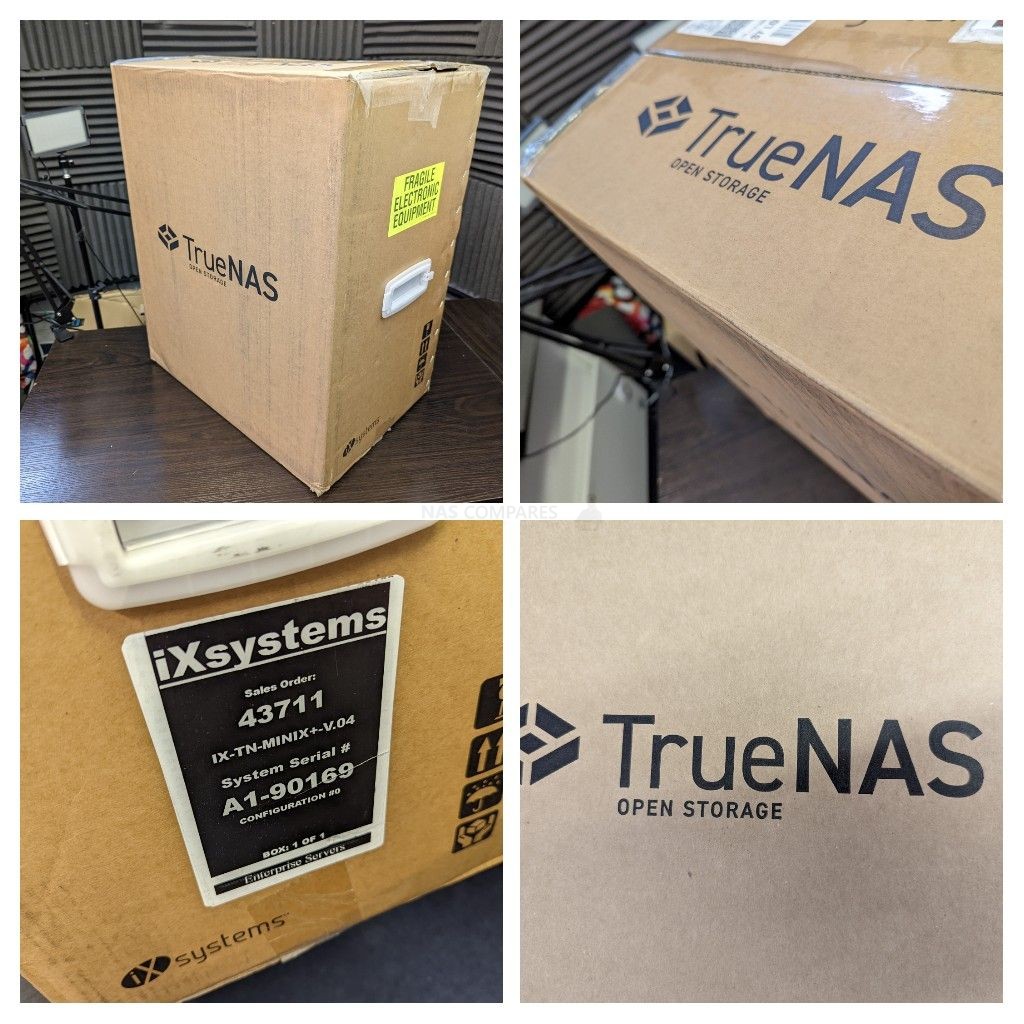
The iXsystems TrueNAS Mini X+ for this review was supplied by the brand themselves and it was a pre-populated solution, featuring 5x WD Red plus Hard drives and 2x ixsystems branded SSDs. In the majority of cases, when you order a pre-populated solution online, this generally means one of two things. Either you get a solution whereby the HDD/SSD media is already installed in the system bays OR you get your NAS enclosure in its retail packaging and the additional drive media separately packaged. In the case of the iXsystems TrueNAS Mini X+ NAS, the drive media is VERY securely protected in pre-cut hard foam, as well as arriving pre-installed inside the media trays.and encased in anti-static packaging. I have said this before in previous reviews, but I will ALWAYS respect a brand that appreciates the silent damage that shock and motion can impact on a system in transit globally and if a system is not packaged with this factor in mind, I am immediately wearing of brand’s long term feelings on the system. Budget/low-end solutions tend to arrive in cardboard frameworks that can withstand little-to-no pressure – I want enterprise solutions that are designed for daily, weekly, monthly and yearly use to arrive with superman-grade protection on day one and I am pleased to say that the iXsystems TrueNAS Mini X+ did not disappoint.
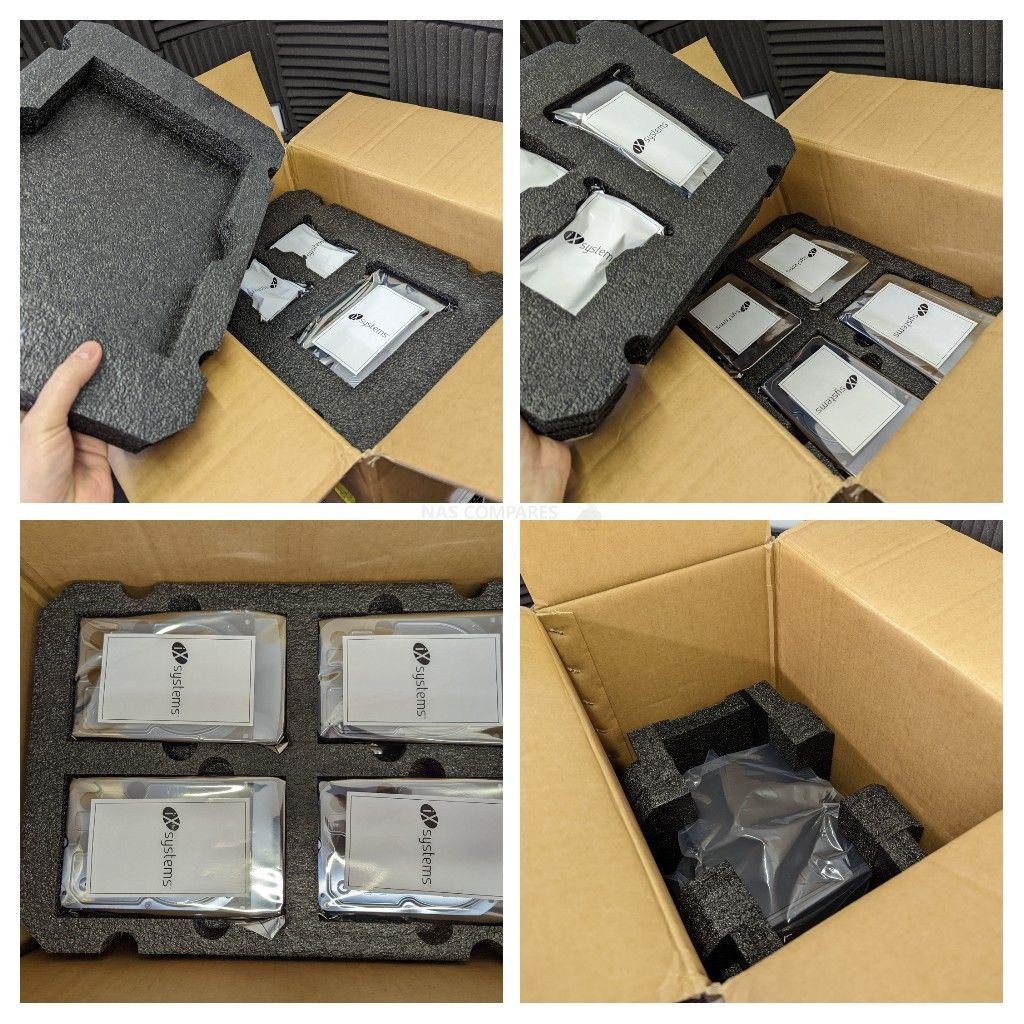
Indeed, moving passed the storage media in this pre-populated system configuration, the iXsystems TrueNAS Mini X+ NAS enclosure itself as also fantastically well protected. Remember, this is a 5x HDD enclosure – the SMB (small-medium business) tier, they could have cut some corners here. Massive respect.
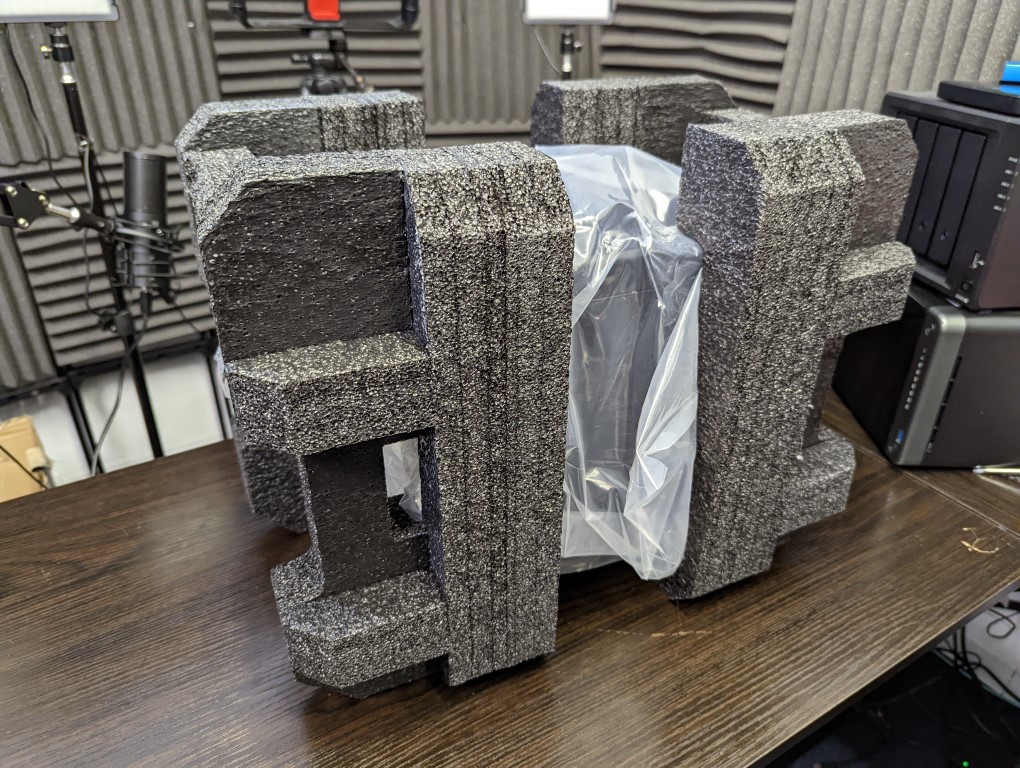
The entire contents of the iXsystems TrueNAS Mini X+ package are largely what you would expect, but the majority of the things that it includes each seemingly are a little bit ‘extra’ than other turnkey solutions. This may seem a little small fry for a system that will typically set you back at $999+ (with the more scaled-up config options being added) but I think it is important to detail that this is a solution that has clearly been presented by people who know where they needs scale up a bit. Remember, the iXsystems TrueNAS Mini X+ is arriving with software that is open-source (i.e Free to download) os alongside the commercial type support that is on the table to the end-user, iXsystems need to make sure that the physical product being purchased here ticks all the boxes.
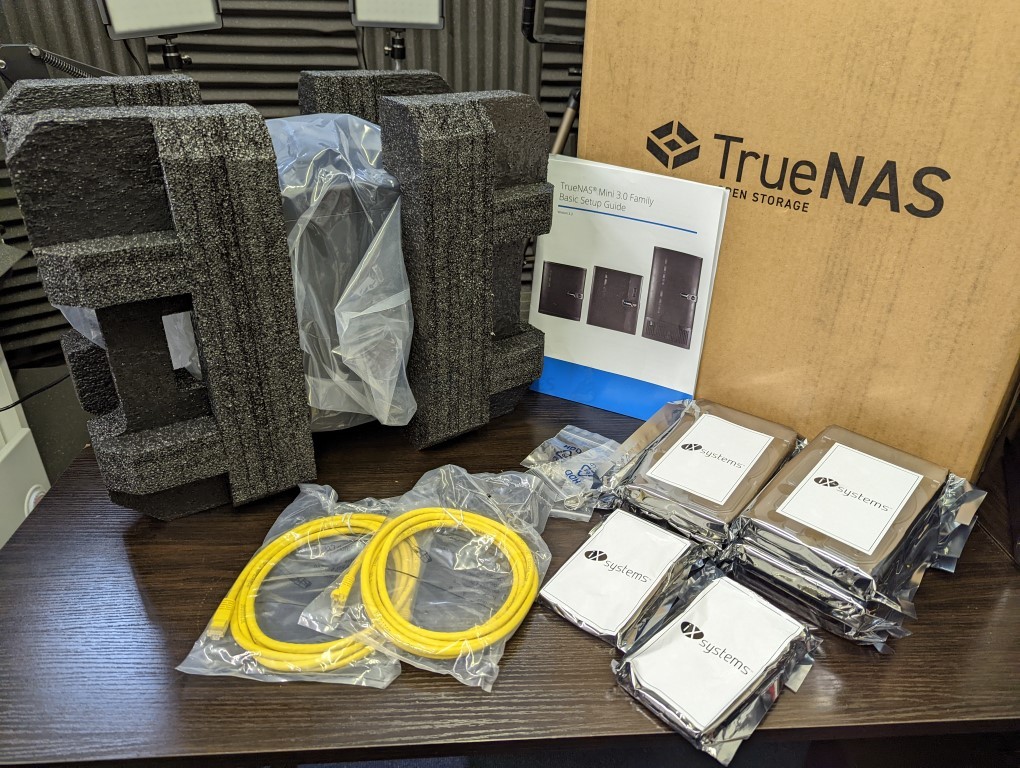
The accessories that the iXsystems TrueNAS Mini X+ arrives with are all in a box in the top of the retail package. Going through them, here is what they were and how they each give a little more than expected.
- Power cable – A standard power cable, but crucially it was a 3 metre cable, not the usual 1 metre that off-the-shelf system tend to be
- 2x ethernet cables – Teo things here, first that it was Cat 6 (not the Cat 5e that a lot of brands offer, EVEN on 10GbE solutions) and that each cable was 7 feet long (not the 1 metre cables offered by most other turnkey solutions by default)
- Key and Screws – fairly standard stuff there to be honest
- Instructions, warranty and first-time setup guide – unlike most brand supplying a single folded sheet of paper that covered just physical connectivity and warranty coverage on a single bit of paper, the iXsystems TrueNAS Mini X+ arrived with a glossy manual, detailed first time setup and information on the security/login credentials all clearly presented throughout
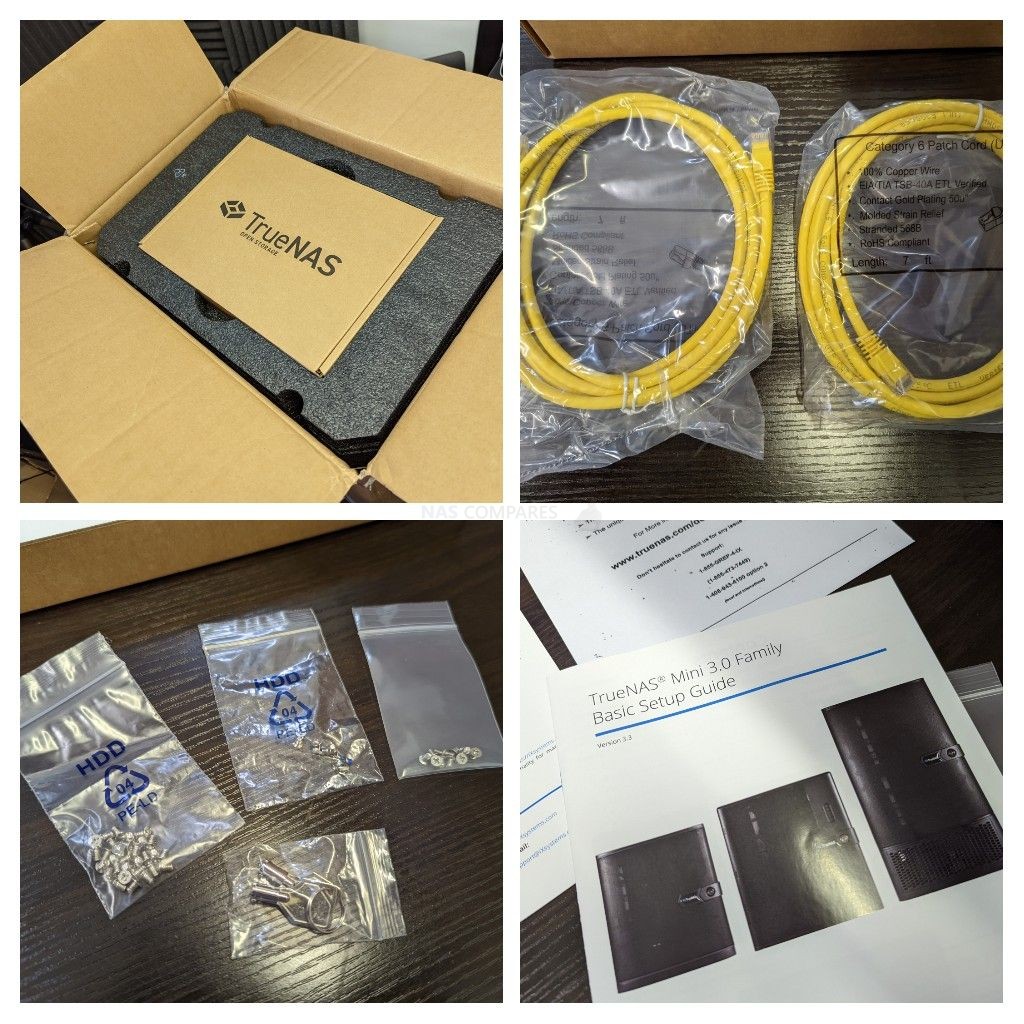
That instruction and first-time setup manual were particularly interesting, as it is something that has been oddly lacking from most other turnkey NAS solutions that I have reviewed. That isn’t to say that it doesn’t;t make sense – the software in most NAS systems is ever-evolving and online resources can be updated regularly as system software gets its firmware updates. This is by no means a global policy and indeed, in my review of a Japanese DS920+ back in 2020 showed that Synology NAS there is also bundled with a thick book of guidance and setup assistance. There are arguments for and against this of course that range from costs to wastage, but on the whole, the glossy manual and range guides that the iXsystems TrueNAS Mini X+ arrives with is a great extra and given that one of the core appeals of the TrueNAS platform is the community support and flexibility in architecture, this is a solid bit of branding by both TrueNAS and iXsystems in the Mini X+ retail package. You can always just rely on the massive range of online resources that are available in the TrueNAS community of course (as well as using the direct guides and support services built into the GUI for TrueNAS in your browser – but it’s also good to have BOTH options on day 1).
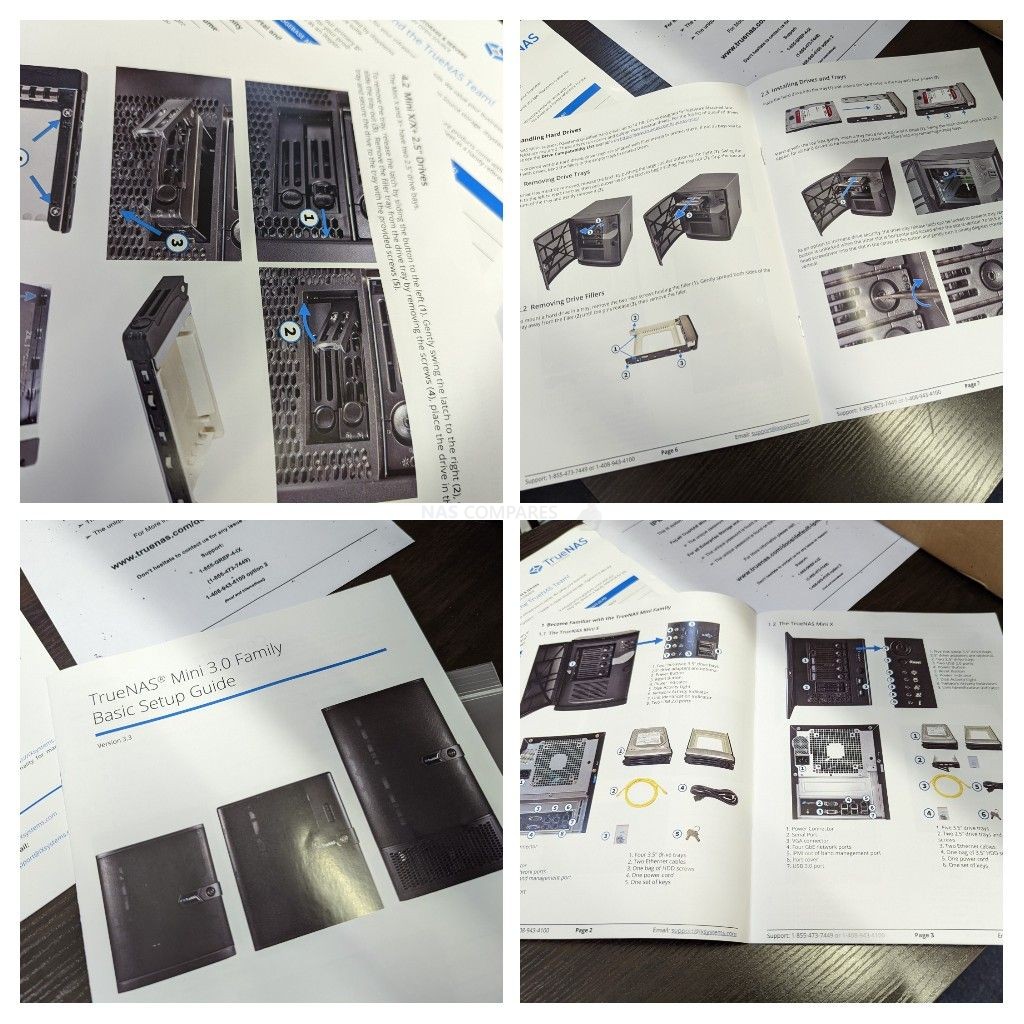
Overall, I cannot really fault the iXsystems TrueNAS Mini X+ NAS packaging and first impressions – it is a big container that largely justifies its ‘extra’ness. Let’s get to grips with the iXsystems TrueNAS Mini X+ NAS itself and discuss it’s design to see where your money goes.
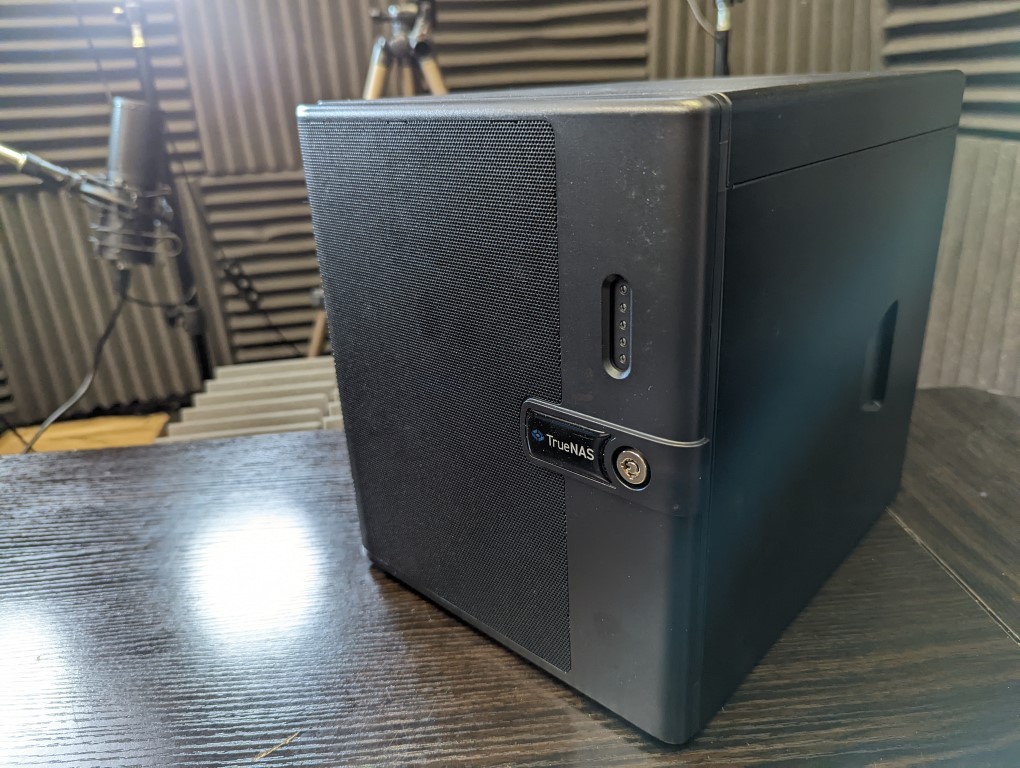
TrueNAS Mini X+ iXsystems NAS Review – Design
The external chassis of the iXsystems TrueNAS Mini X+ is a surprisingly compact enclosure and despite the largely free nature of the software, this is a remarkably modern designed chassis that definitely gives Synology and QNAP a run for their money. Arriving in a taller casing than most 5-Bays in the market, the system features a mesh front door, multi-stage locks, numerous LEDs and definitely gives you a feeling of quality about the product. In my past experiences of the open-source platform, I have never seen the software on anything but rackmount and reused PC tower chassis, so the iXsystems TrueNAS Mini X+ look and feel is particularly stand out for me.
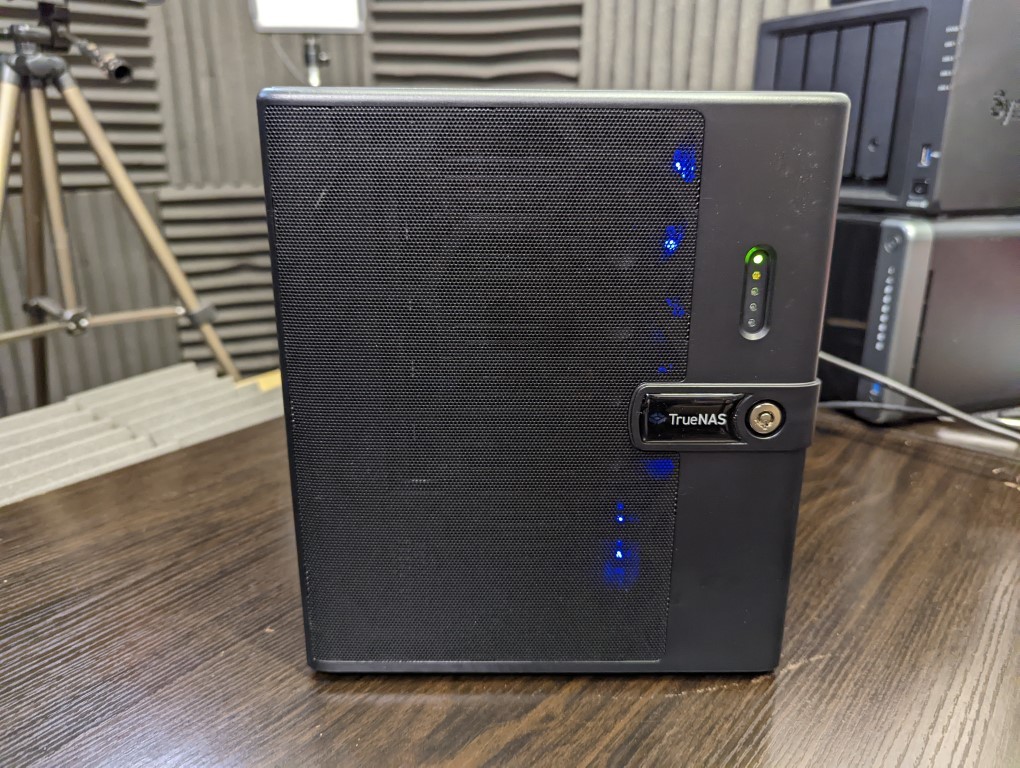
The first thing to look at is that hinged door. Servers with covering mechanisms to shield drive media bays from dust or accidental removal always run a slight risk of impeding airflow, but in the case of the iXsystems TrueNAS Mini X+ I think things are perfectly fine. The door is fully mesh ventilated and at no point covers the existing areas of passive ventilation on the front of the chassis. Indeed, the mesh also serves as an additional layer of dust capture which, although will need occasional cleaning, means that dust will not be drawn through the front of the system and into the NA Sby the active cooling fan.
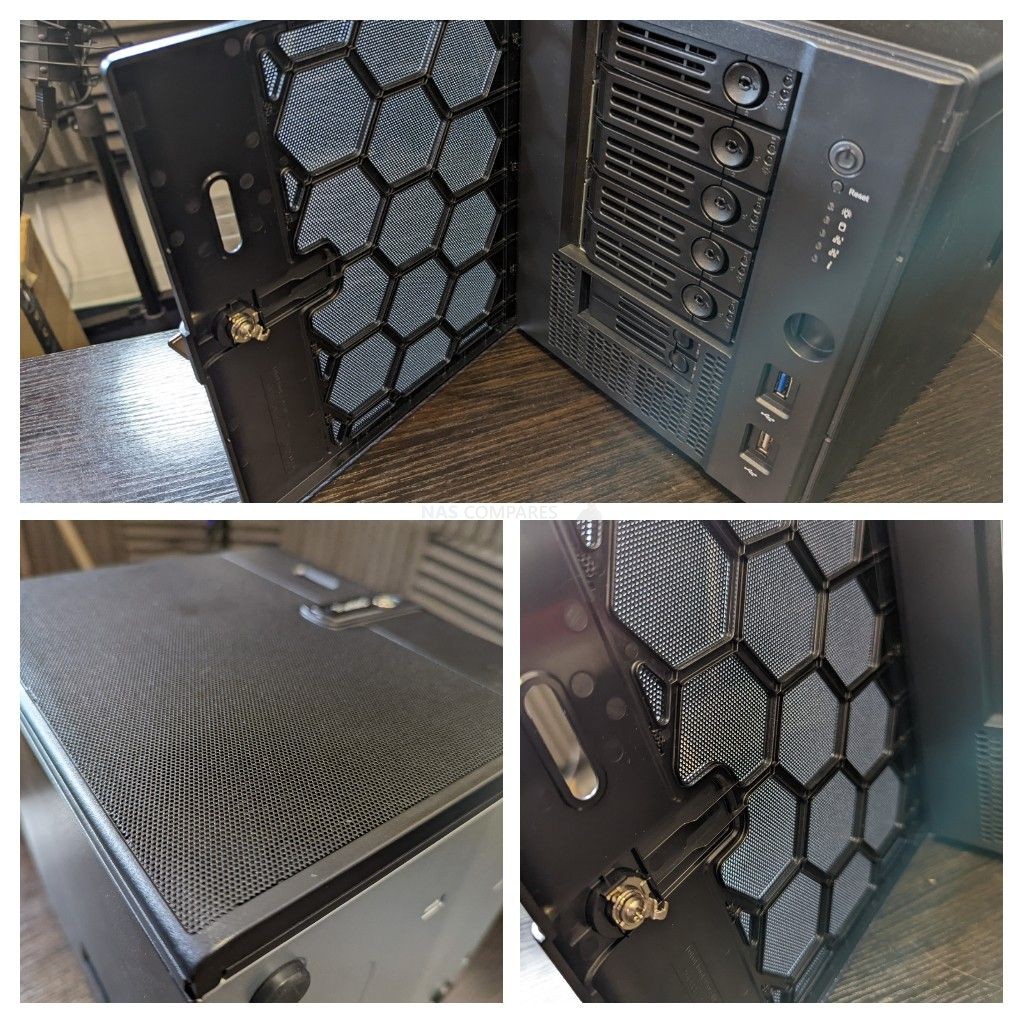
The door also features its own lock and key (with 2 keys included in the accessories kit). It is also worth highlighting that although the key locked door IS a good idea to prevent accidental drive removal, it also has a couple of rather annoying consequences. One is that the closed and locked door will obstruct the USB ports inside, which although makes sense to prevent things from being connected without permission, is largely made redundant by the fact that a nefarious user can STILL access the rear USB ports unhindered anyway. So now all this seemingly does is stop you from attaching USBs to the front of the system without having the door hanging open. Additionally, the power button for the device is located on the inside of this hinged door and therefore powering the device on also needs keys in order to access the ON switch. Again, it was likely done to stop using from powering the system off in error/foul-place, but you can still just pull the power cable out the back anyway and in the event of the system powering down for maintenance or in a UPS power down situation, you are going to need keys just to turn the device on. I genuinely love to finally see the TrueNAS logo on a premium product, but the amount of things this door covers seems oddly unnecessary.
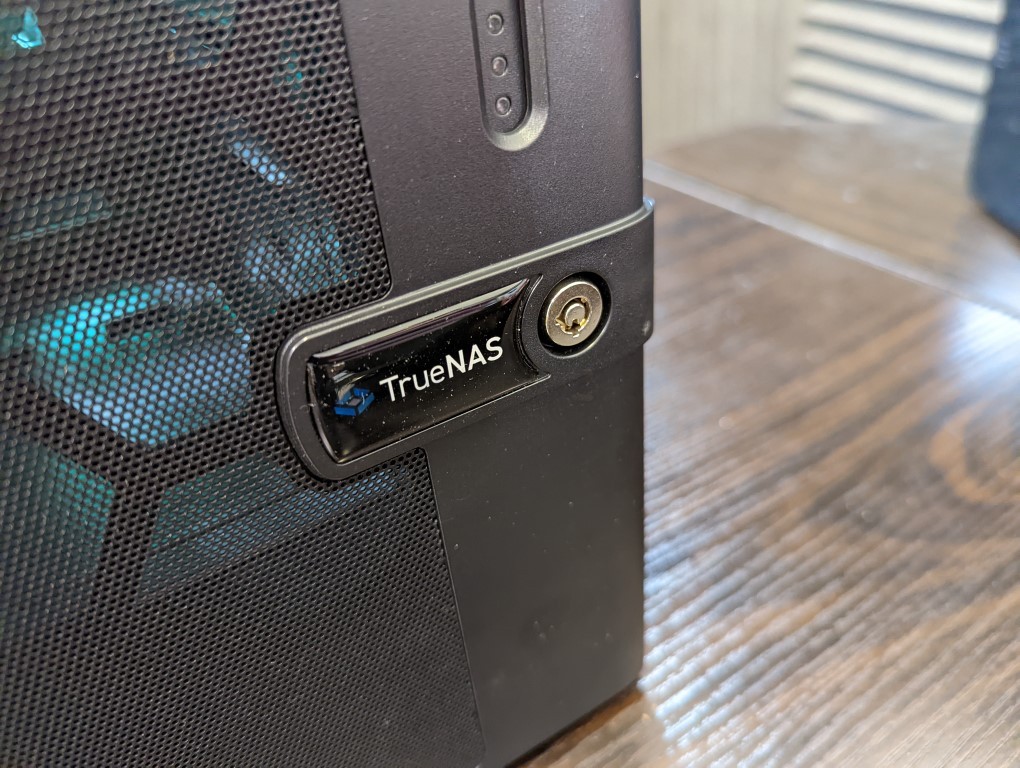
The iXsystems TrueNAS Mini X+ NAS also features numerous front-mounted LEDs to give you real-time information about the system activity, network activities, storage media access and health of the NAS on the fly. These LEDs are incredibly clear, even though the mesh front door panel. Once again though, an odd design choice with the hinged door in that the five system activity/health lights are visible above the lock BUT there is no icons, logos or guidance to what they are denoting. Open the door and all of them have the clear purpose icons, but why not have them on the outside door? Especially given how often this door will be closed. The system and LEDs all look great, with the option to change their brightness in the system settings, but I am surprised by the understated approach to them when you shut the door.
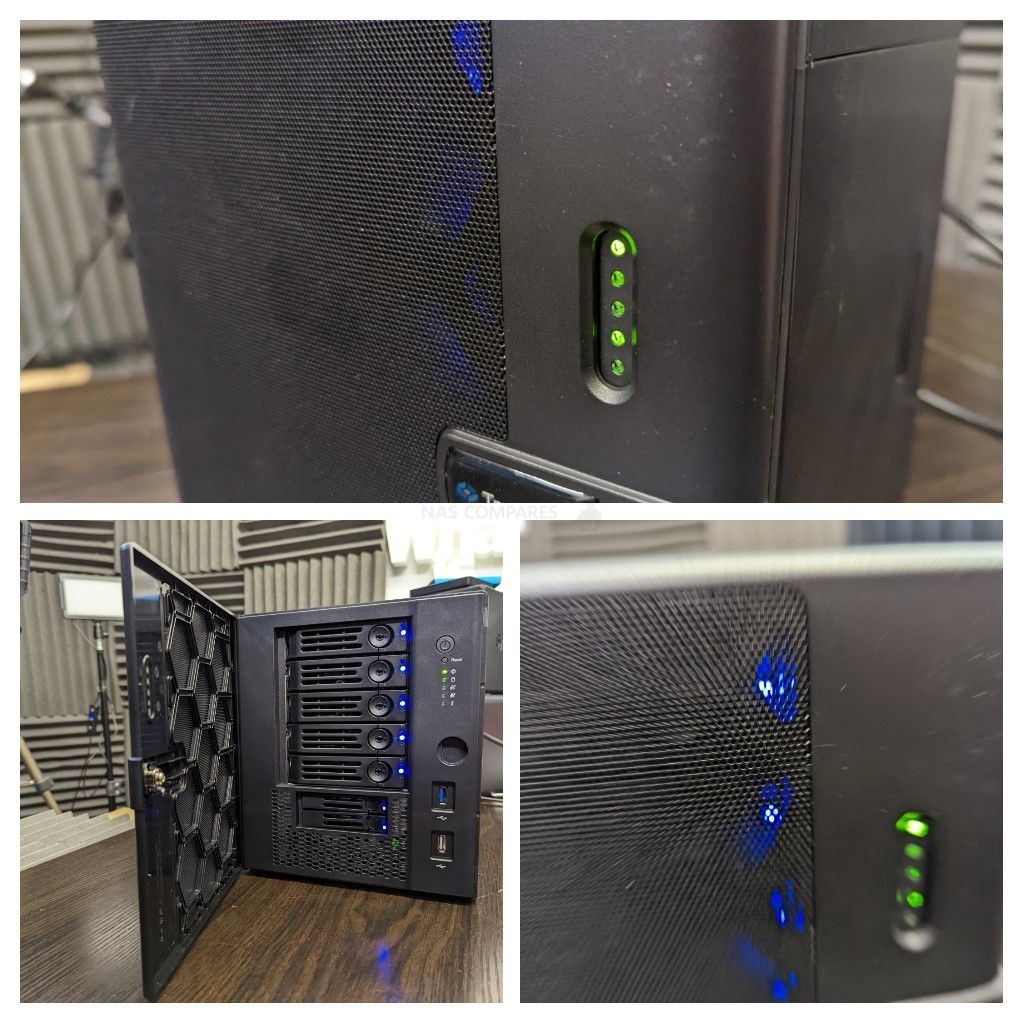
The rest of the surrounding chassis is fairly standard, the system clearly employs a horizontal funnel ventilation system, with an active rear fan drawing air throughout the system whilst in operation. There are no side vents and the base of the iXsystems TrueNAS Mini X+ chassis does not feature anything more than the rubberised feet. Memory upgrades and other component changes need to be made with removing the side/top panels of the system. The chassis is still a remarkably clean and compact designed affair that although mostly metal, is not as noisy in operation as I would have thought.
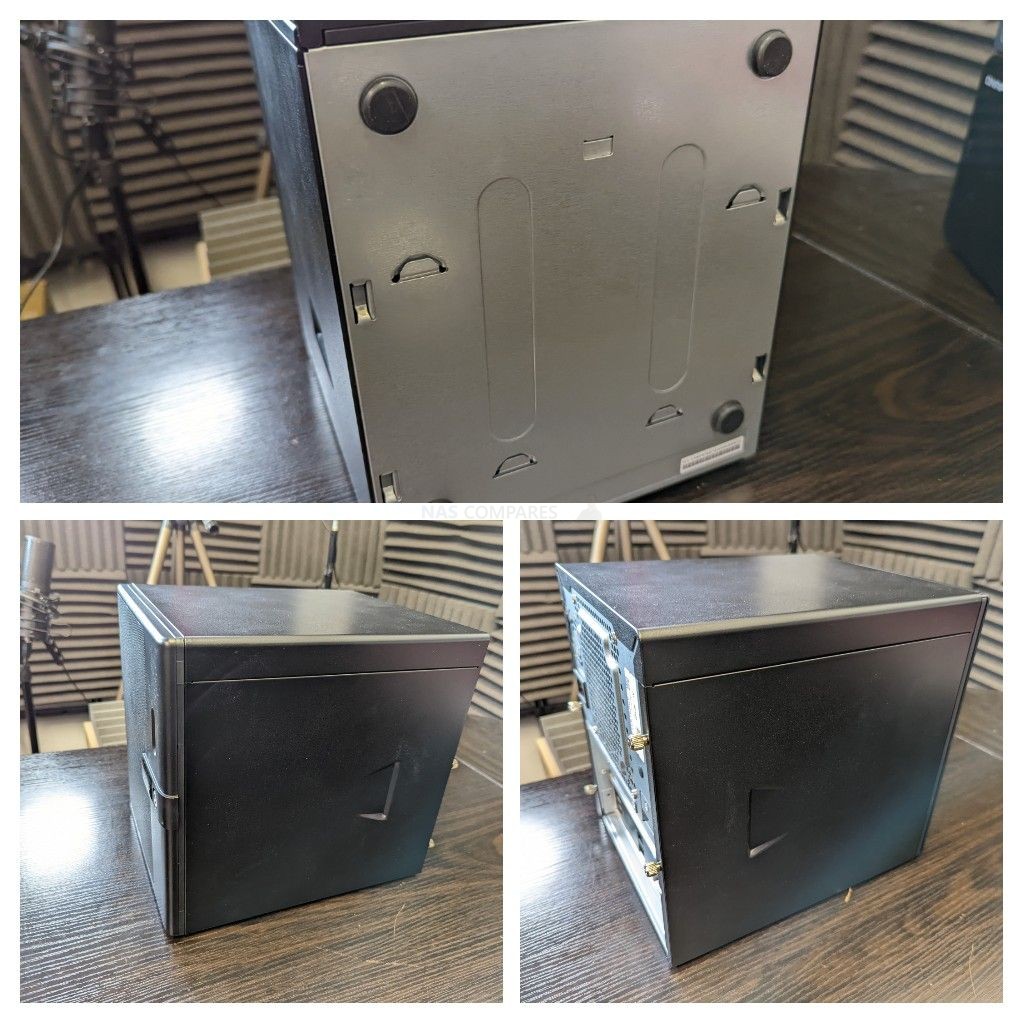
As mentioned earlier, the iXsystems TrueNAS Mini X+ that was supplied for this review arrived with several storage media drives included, an option that can be scaled to the user’s needs at iXsystem’s website. Let’s discuss the HDD media and bays first.
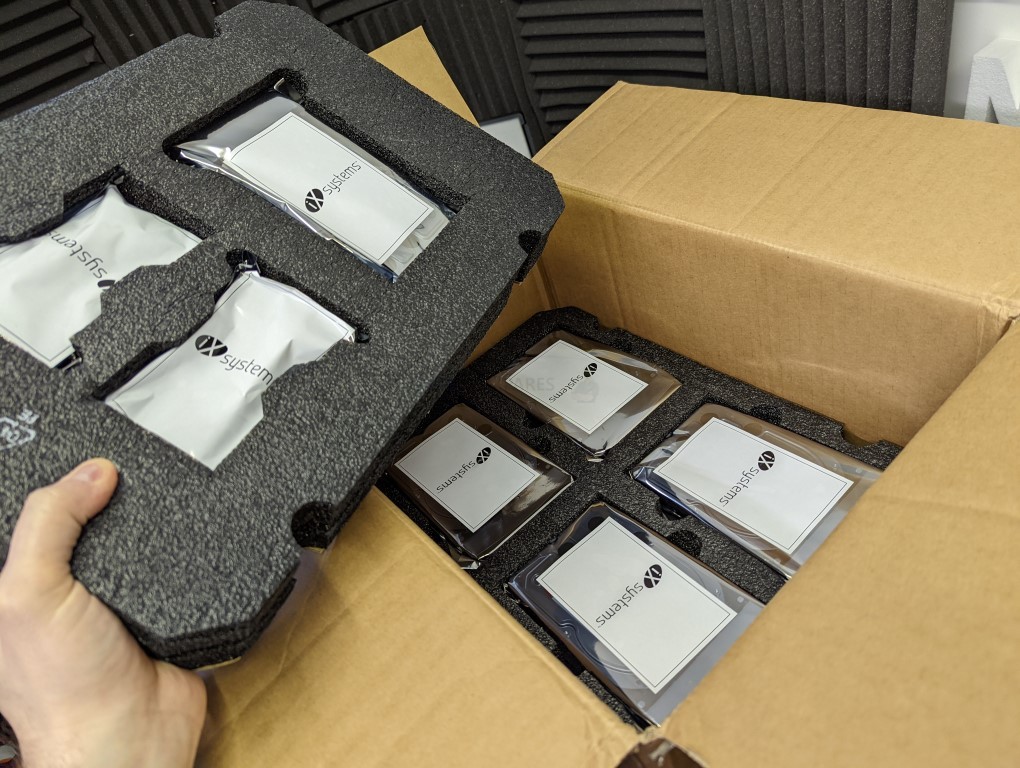
The iXsystems TrueNAS Mini X+ features five SATA bays that are dual power-data (so no loose SATA or POWER connectors knocking around) and with each HDD arriving already installed in the tray, installation is quick and easy. TrueNAS runs on an additional SSD inside the system by default (we will touch on that later) so that means that these drives do not store the operating system, they are purely for your ZFS based RAIDZ storage. Alongside the lockable front door of the iXsystems TrueNAS Mini X+, each of these bays is vented at the front to assist passive airflow and they even arrive with their own locking mechanism, as well as the trays being springloaded to ensure the connection is smooth. 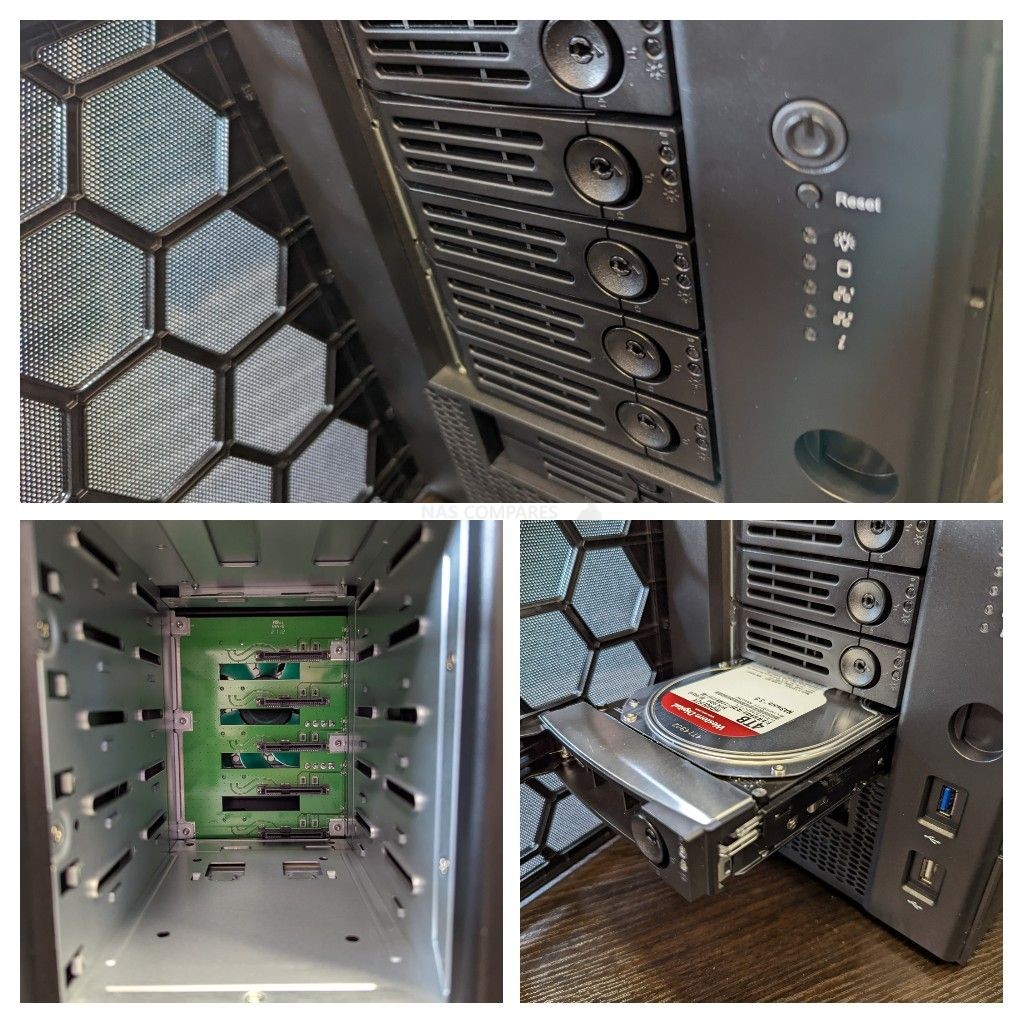
The two SSD bays are built similarly to the HDD bays, are springloaded, dual SATA-POWER connectors and are ventilated but lack their own locks. I will also add that TrueNAS does not limit how you use these SSD media bays, you can use this media for faster storage pools, for caching or Fusion pool use in conjunction with the HDD based RAID. Additionally, the SSD bays are DEEP! If you were considering much bigger enterprise SSDs at the 15mm height level, the iXsystems TrueNAS Mini X+ will easily support one in each bay. The iXsystems TrueNAS Mini X+ can be purchased unpopulated or populated too.
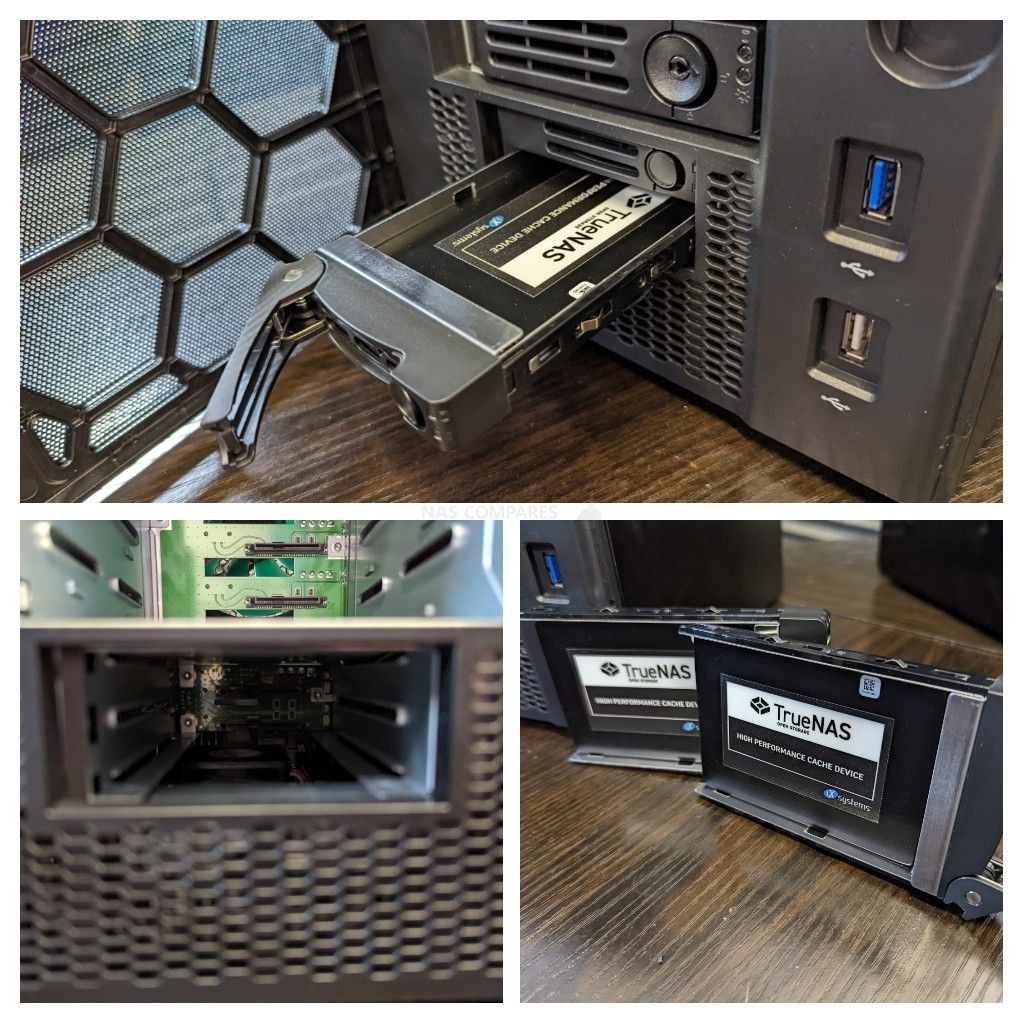
Those USB ports I mentioned earlier are also worth touching on a little more too. The iXsystems TrueNAS Mini X+ NAS features two USB ports on the front of the device (USB 3.2 Gen 1 and USB 2.0) which is pretty unusual for a desktop NAS (typically x1). The range of uses for these USB ports range from adding additional storage and backup drives, to USB printers, UPS’ and can even support KVM deployment with the rear-mounted VGA port for those that want to directly connect on a command level to the system.
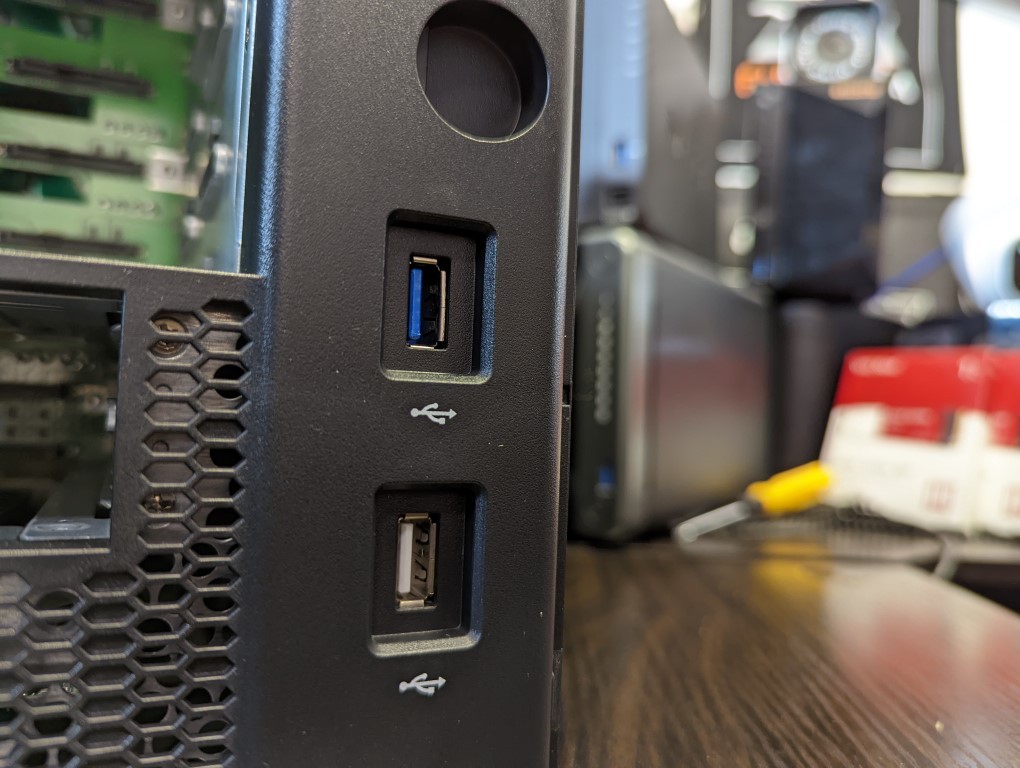
Overall, aside from my reservations about the door of the iXsystems TrueNAS Mini X+ covering some things necessarily, the design and overall chassis of this NAS is very well put together. Arriving a little more comparable to a shuttle PC case than the more closed understated NAS chassis from Synology and QNAP, it still manages to look very ‘business’ and you aren’t left thinking it is not robust. Let’s discuss the ports ad connections of the iXsystems TrueNAS Mini X+ NAS.
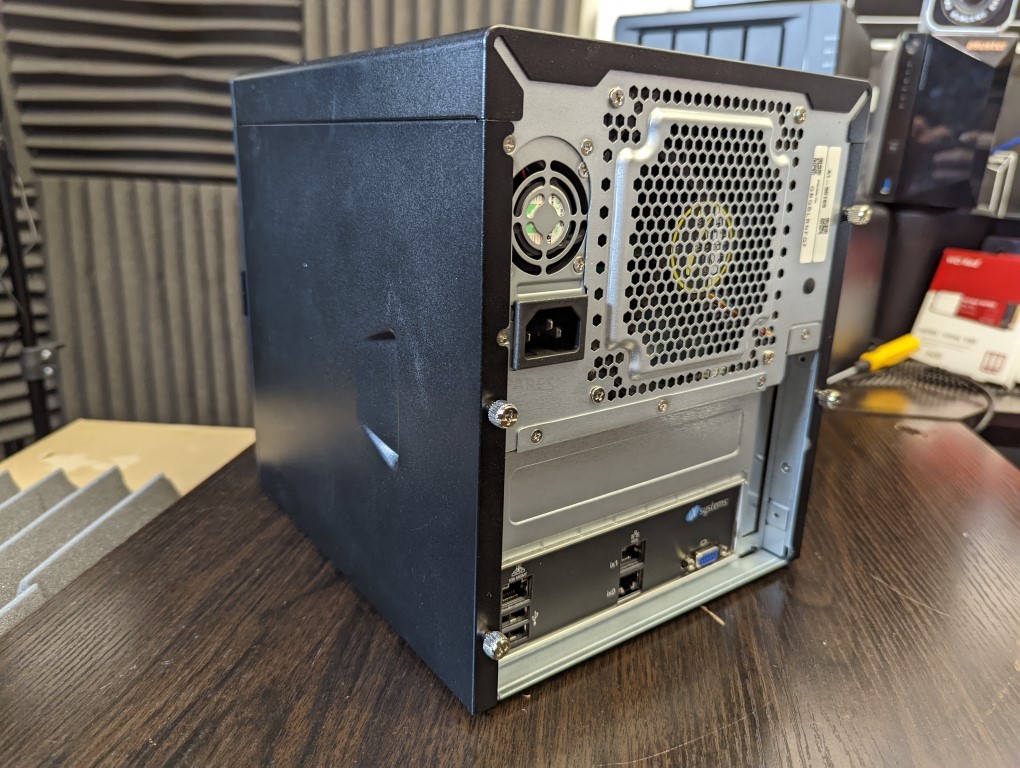
TrueNAS Mini X+ iXsystems NAS Review – Ports and Connections
The rear of the iXsystems TrueNAS Mini X+ NAS is a little more industrial than the slick front of the chassis would lead you to believe. The is tonnes of ventilation for that large rear active fan, as well as the fan for the internal PSU. Accessing the internals of the system is made possible with simple thumb turn screws, but before we get to the internal hardware of this NAS, let’s discuss what we have here.
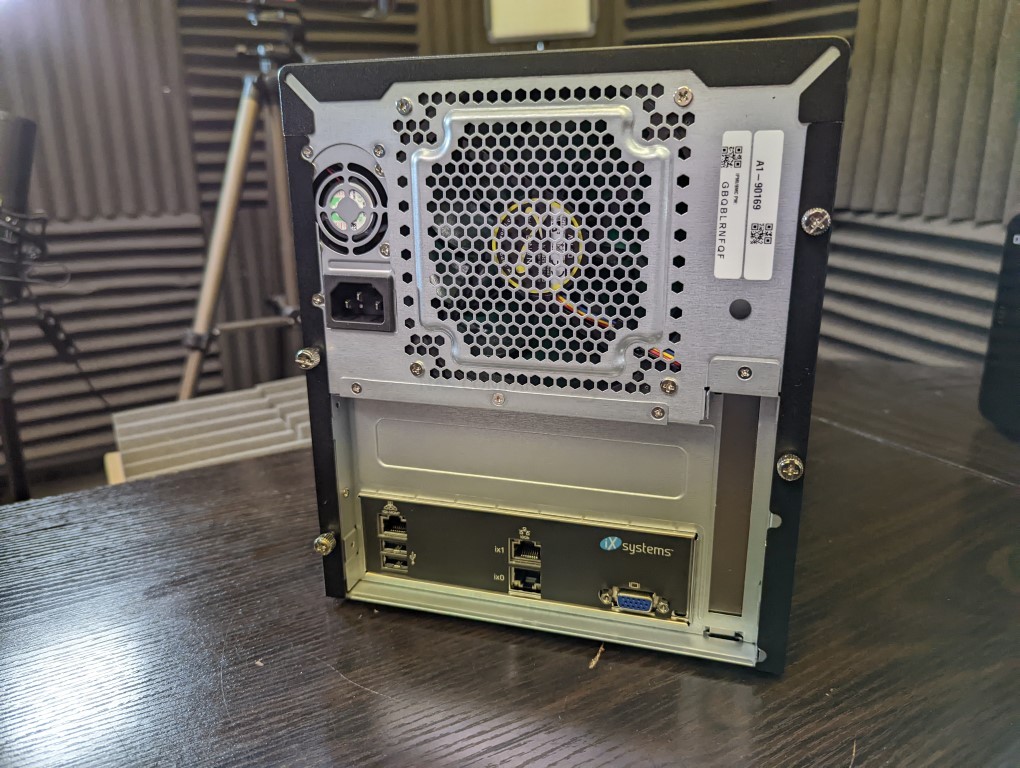
The rear fan and vents take up 50% of the rear of the device and it is noticeably quieter than I would have thoughts a mostly metal NAS with a fan/vent this big would be. It IS still a pinch higher in ambient noise than other 5 bays on the market, such as the Synology DS1520+ and QNAP TVS-h973AX, but not by a vast amount.
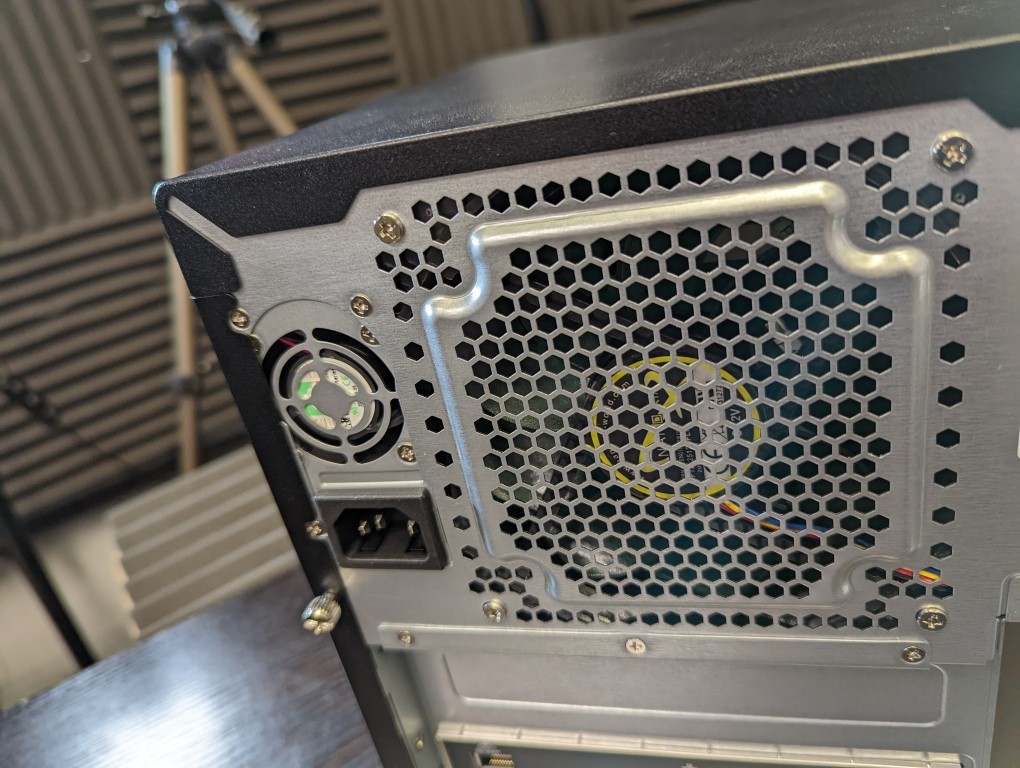
The iXsystems TrueNAS Mini X+ NAS does support a level of local access via a KVM setup as mentioned earlier, that allows you to access a command structure based UI that you can use to run troubleshooting and push SSH commands. Now, the UI you are going to be using is NOT the GUI of TrueNAS Core, this is simply an alternative to SSHing into the system remotely. The use of VGA and not HDMI as a visual out (when VGA visual monitors are hardly mainstream in the 2020s) is a little underwhelming, but given that the system is not using a processor that features embedded graphics and this form of system access is going to be rather low in general use, I think I can let this go for the most part.
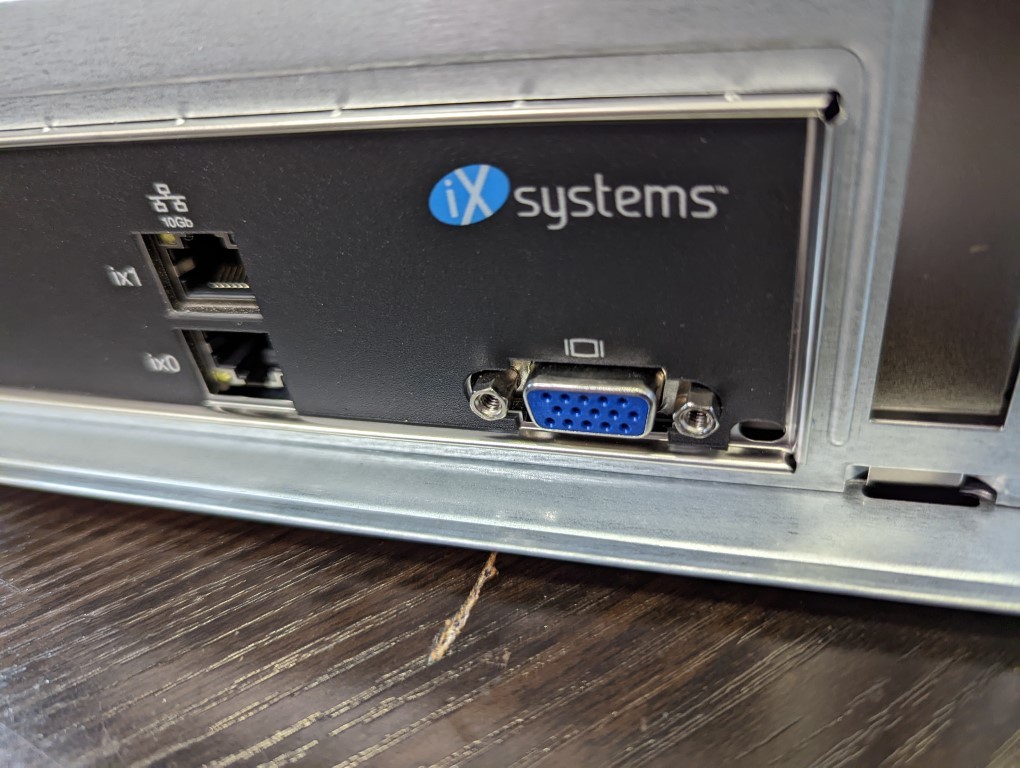
What IS interesting about the iXsystems TrueNAS Mini X+ connections though is that the system arrives with two 10GbE network ports by default. Now, if you factor in that the nearest you can get to a 5-Bay with 2x 10GbE from the off-the-shelf brands are the $1500 QNAP TVS-672X or the $1600 DS1621xs+ (both of which would arrive unpopulated) the iXsystems TrueNAS Mini X+ coming with 2x 10GBASE-T ports at this price is really, really impressive. You DO of course have to factor in that it is using open-source (i.e largely free) software unlike the other two, but this does definitely put the price tag of the iXsystems TrueNAS Mini X+ into a greater perspective. That said, it is also worth keeping in mind that this IS a 5x SATA 3.5″ and 2x 2.5″ SATA NAS enclosure. Although I CAN see this media saturating a single 10GbE port (i.e 1000MB/s throughput), I don’t think you will even be in a situation where you will saturate both 10GbE ports here (i.e LAG/Trucking at 2,000MB/s) unless maybe, MAYBE you filled the device with enterprise-grade SSDs in the 7 bays. Nevertheless, the idea that you can run multiple connections to this device will mean that that high performance will still be accessible to a good % on each connection, meaning that there will be plenty of bandwidth to share out and a decent level of storage inside to fill it.
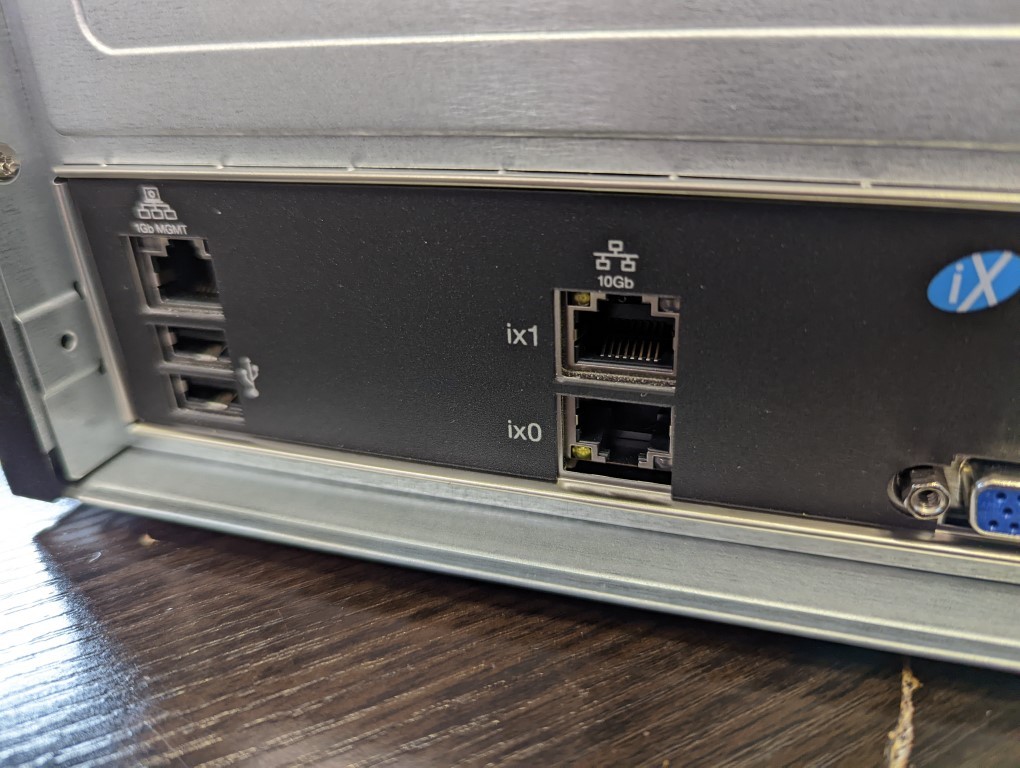
The system also features two more USB ports (USB 2.0L sadly, likely geared towards that KVM access option and/or UPS heartbeats) and also an additional network port. This is a 1GbE management port and is something we are seeing appear more and more in modern enterprise hardware. Out of band system management and a fixed connection to the internal control UI for maintenance and/or troubleshooting can be remarkably useful, especially in situations where there is a fault in the greater network preventing you from patching in conventionally.

After the inclusion of the two 10GbE ports on the iXsystems TrueNAS Mini X+, I was genuinely surprised to see that they still had enough umpf in that CPU, the chipset and PCI lanes to also include a PCIe Upgrade slot. Now, the range of options that this bay can be used with is pretty vast (thanks once again to the open-source and free-roam user methodology of TrueNAS when it comes to its design). That said, it is worth factoring in that this port is a PCIe Gen 3 x4 slot (again, I am still pretty surprised it is there at all, given the available storage connections, the additional internal system SSD and those 10GbE ports) and that means that whatever card you using in that slow will not be able to exceed around 4,000MB/s in communicative bandwidth. I am not entirely sure the system would benefit from more 10GbE ports (given the unlikelihood that the 7 media bays here would already saturate the 20GbE possible by default anyway), but the ability to add storage expansion cards, performance enhancement cards, perhaps even wifi cards and maybe even a compact graphics card (it would need to be pretty compact though) to assist those JAIL programs from Plex Media Server transcoding to VMs. A very welcome surprise here.
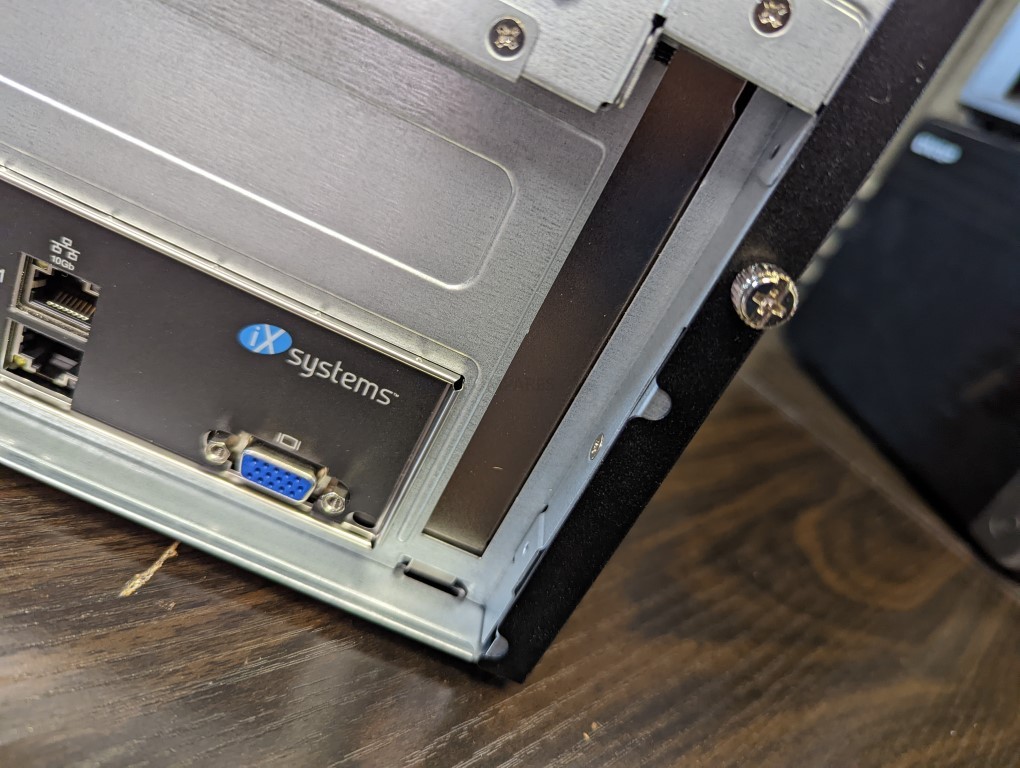
Overall, the ports and connections on the iXsystems TrueNAS Mini X+ are largely better than I would have ever thoughts for a system of this price/scale. Add to that the scalability in a bunch of ways by that PCIe slot and you really have something genuinely impressive here to build from in a connections sense. Let’s discuss the internal hardware of the iXsystems TrueNAS Mini X+.
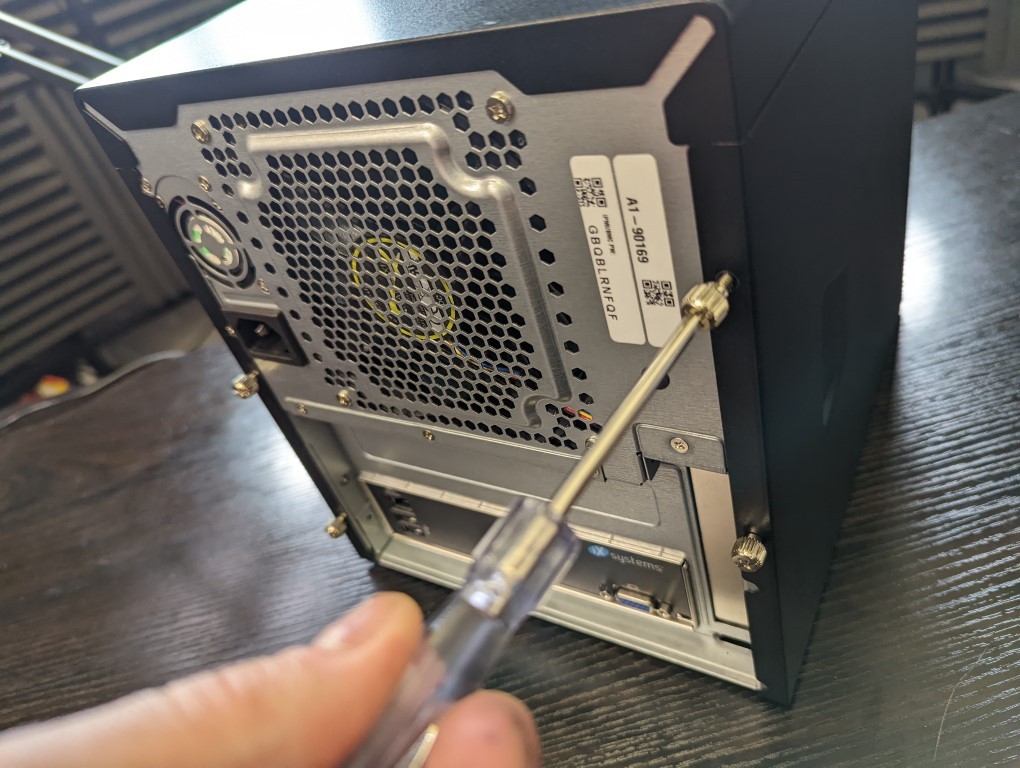
TrueNAS Mini X+ iXsystems NAS Review – Internal Hardware
Once you remove the individual side panels of the iXsystems TrueNAS Mini X+ NAS chassis, you find a system that is a little more familiar to PC builders and is much, much more akin to the PC under your desk. The layout is less streamlined than Synology and QNAP NAS systems, but is still quite a today build and the few wires that are visible are all suitably tied and/or trunked.
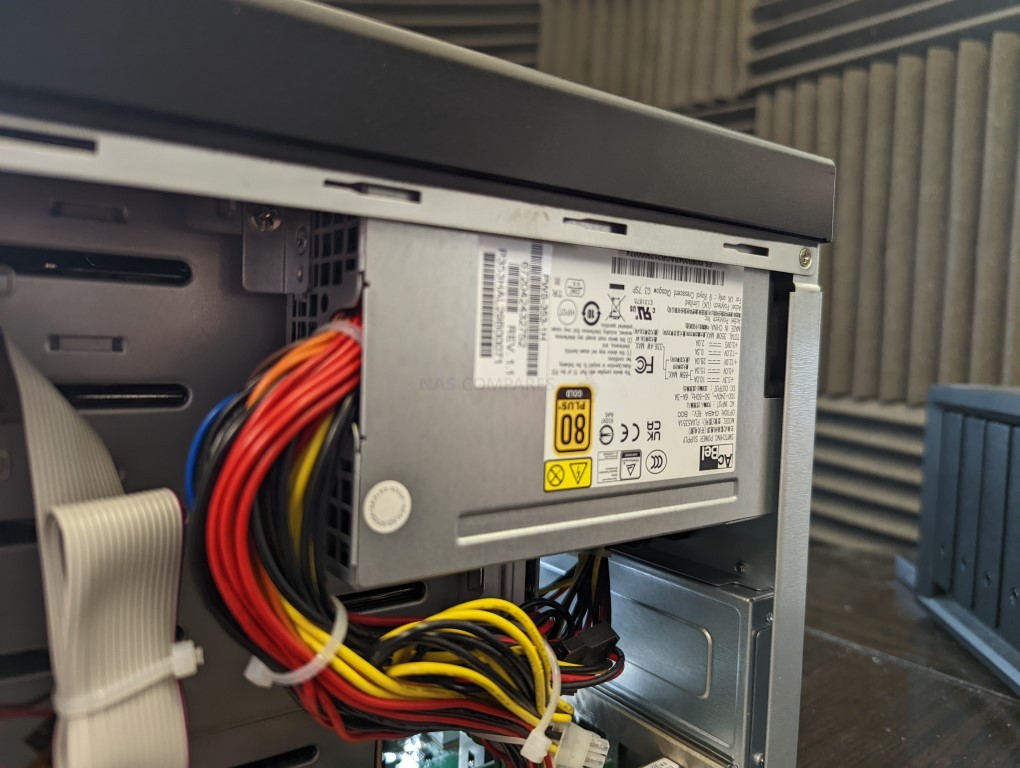
The internal PSU is a compact profile model and is held in the top panel. This PSU (playing devil’s advocate here) is NOT going to be fun to replace in the event of failure (the PSU is the 2nd most vulnerable part of a NAS next to the storage media!) as it is pretty well embedded behind all the other components. The system does arrive with a 1yr warranty by default (a noticeable difference to the minimum 2 years and upto 5 years on Synology/QNAP SMB solutions) which can be expanded upon by using the tiered support levels from iXsystems, which would likely over this being replaced, but would they replace it or send you out a new PSU? I will look into that. Otherwise, the PSU here is a decent size, good quality and manages to deliver enough power for this well-equipped system, whilst not being overly large and forcing the system to be much bigger.
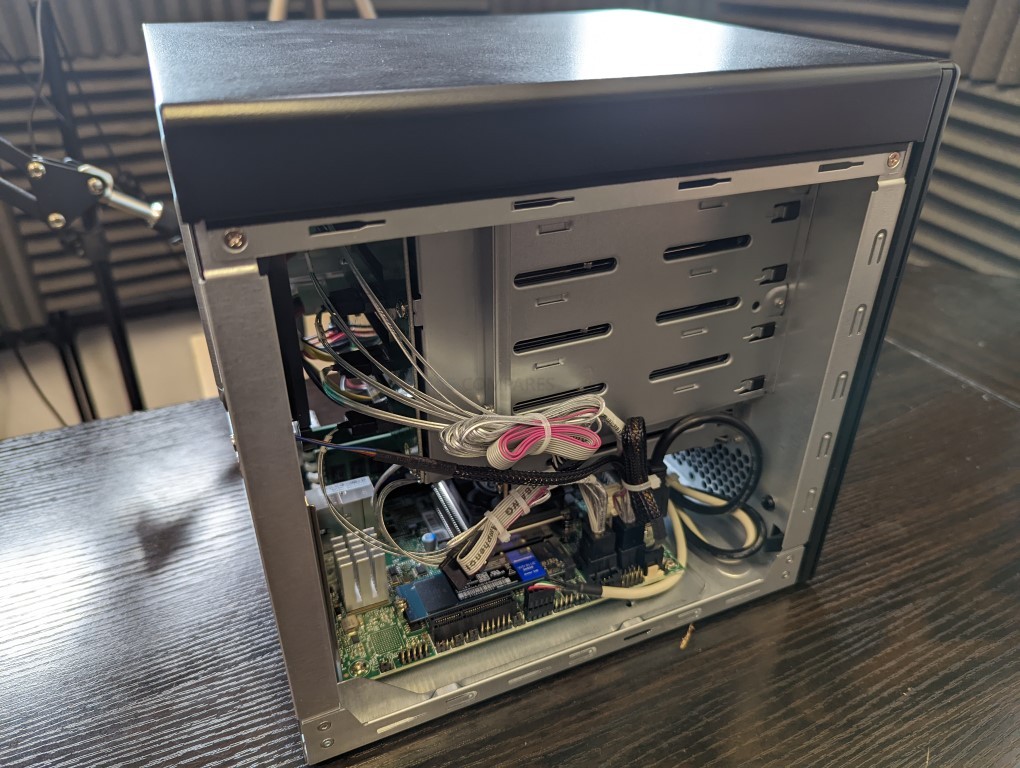
The other side of the chassis shows us a whole bunch more wires (again, well kept though). From here we can see the SSD that the iXsystems Mini X+ NAS hosts TrueNAS Core from. Now, I fully expected to see a standard 120/240GB SATA SSD here (as TrueNAS itself is not a huge program once you understand that the software lives on an independent boot drive from your actual RAIDZ/Pools. However, I was very pleasantly surprised when I noted that the system arrived with a 250GB WD Blue 550 NVMe SSD. Now, a couple of things. First off, I am still staggered how much the CPU/Chipset and it’s PCI lanes are being stretched here. An NVMe M.2 Bay, 7 SATA bays, 2x 10G and a PCIe 3×4 – this is seriously impressive to have an m.2 NVMe bay here. Next, the OS living on an NVMe SSD and not a SATA one means that the software will run CONSIDERABLY faster and feel a great deal more responsive. I would query the PCIe generation of that NVMe slot (PCIe 3×1 or PCIe 3×2 at most, surely), but that would still allow 1,000-2,000MB/s bandwidth for that SSD, which it can DEFINITELY saturate. This is a very impressive choice of SSD for the TrueNAS boot drive indeed.
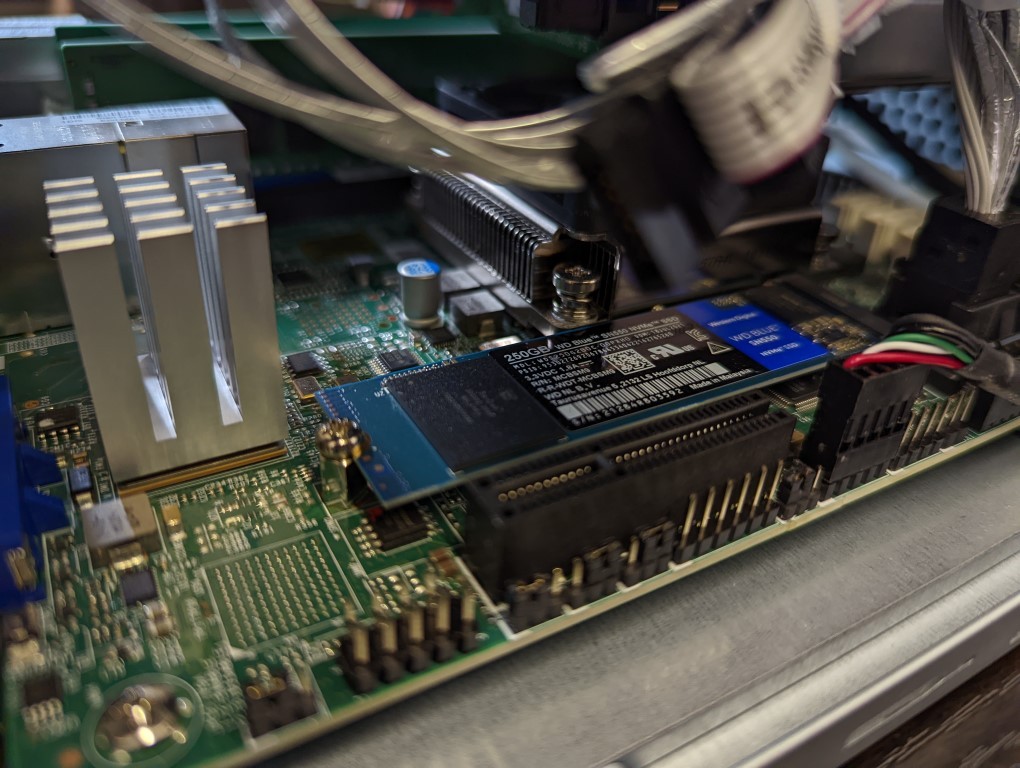
Next, we can talk about the CPU inside the TrueNAS Mini X+ server. This iXsystem NAS arrives with an impressive C3758 Intel CPU, which features EIGHT cores and has a clock speed of 2.2Ghz. Although this is a little old as a CPU (released in late 2017) it is still a very efficient CPU for a 24×7 server that scored a 4675 on CPUBenchmark.
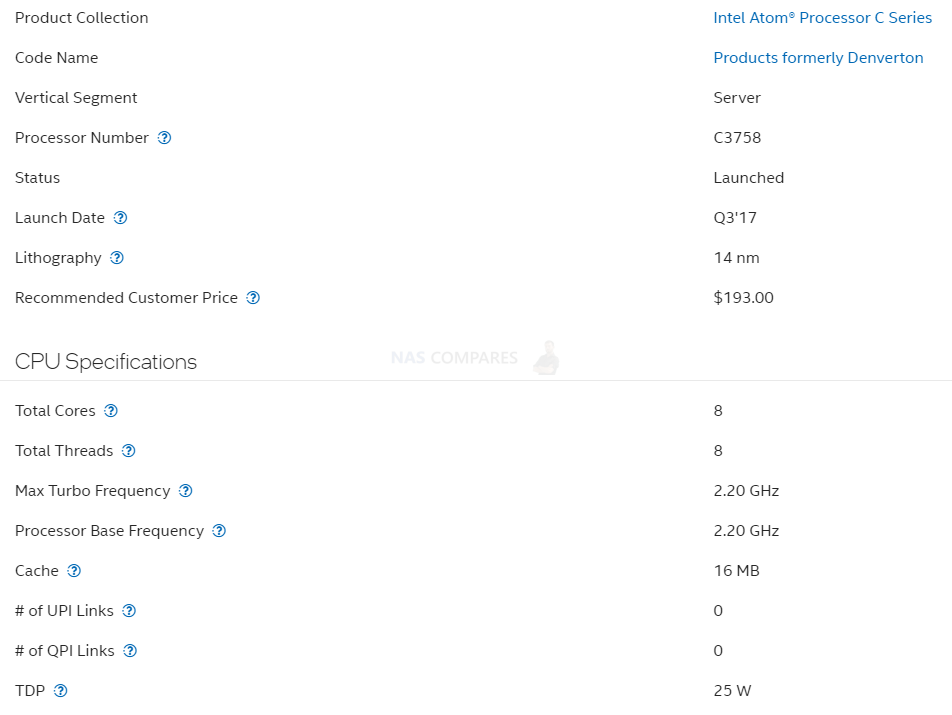
This CPU is placed under a tall heatsink panel (instead of an active CPU fan for the sake of power efficiency and passive cooling over day, week and monthly periods, which is pretty standard on NAS servers) and is a solid choice for VM deployment, as well as assisting fast file server access via those 10GbE ports. Alongside that CPU, the system also arrives with two RDIMM memory slots. The unit for this review arrived with two DDR4 modules and the system when provided by iXsystems will always feature ECC (error-correcting code) supported modules, supporting upto 64GB here. The CPU can support much higher, but likely limitations of how much slots could be added physically and by the available architecture of the hardware already being pushed means this was not going to be an option. Still, an 8 Core x86 64bit Processor, upto 64GB of DDR4 ECC memory and the system software running from an NVMe SSD – this is a lot to get your teeth into on day 1.
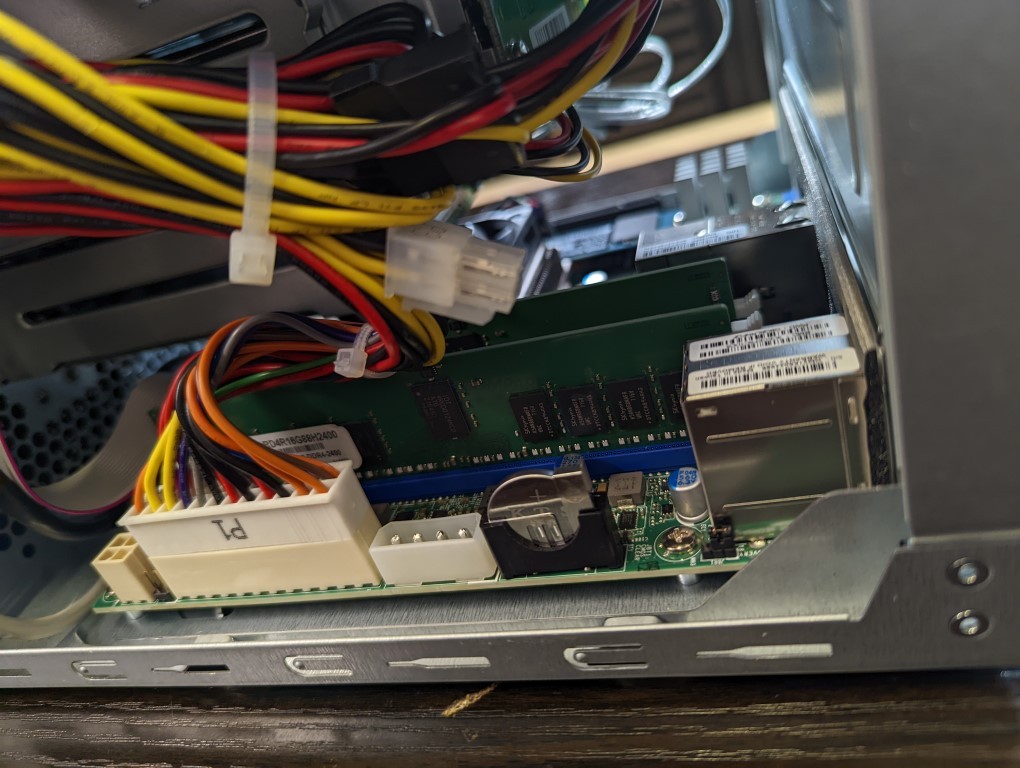
Let’s delve a little into the TrueNAS Core software that the iXsystems Mini x+ arrives with and see just what all the fuss is about.
TrueNAS Mini X+ iXsystems NAS Review – Software
Now, iXsystems are the hardware arm of TrueNAS and when you purchase the Mini X+ NAS system, it arrives with the latest full release of the open-source software. Now, trying to cover everything that TrueNAS Core can do and offer the end-user would be around 5x longer than this review, so rather than repeat myself, I would direct you to check out my full video and written review on TrueNAS core below. Otherwise, here was the conclusion of that video review to give you some idea of what I thought of TrueNAS Core (running on this very Mini X+ NAS):
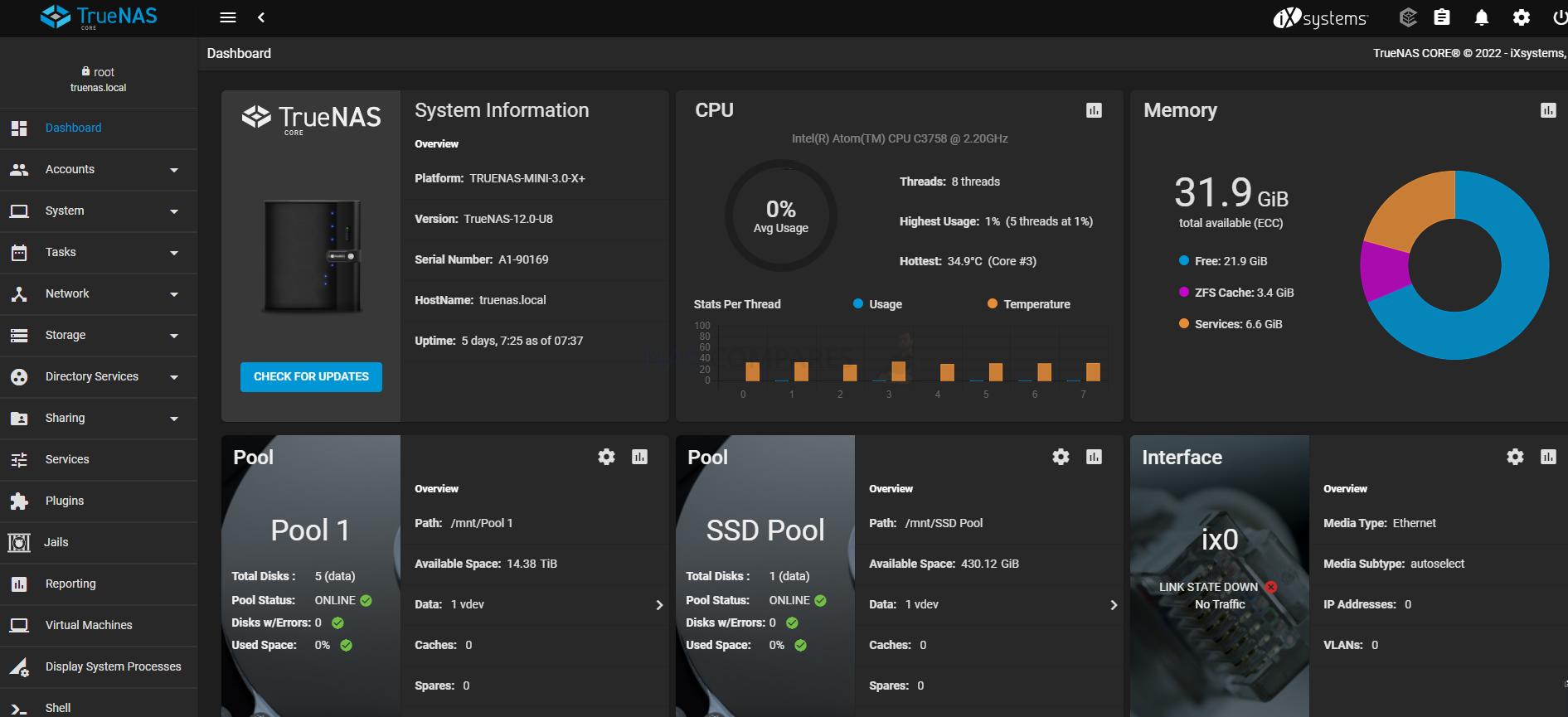
It will come as absolutely no surprise to anyone that when it comes to TrueNAS is a fantastically capable software for managing your storage. It even manages to swerve the downfall of being ‘too enterprise’ but arriving as an open source free software platform to be enjoyed by businesses and storage enthusiasts. There is no avoiding that it IS quite a technical mountainous learning curve if you are arriving at it from a position of zero storage or network experience, but the last few big TrueNAS system updates have gone a long way to update some UI elements to be more intuitive, software wide help notes available at all times and the community support is as on-point at it has ever been. If you are a home users looking for a hurdles setup or a day-1 deployable system for your small business, then TrueNAS may be too big a jump for you and you would be better off with a traditional off-the-shelf NAS system. However, if you have the know-how, you have the willingness to get your hands dirty and already have the hardware in mind/in-house, then TrueNAS stands in a class of it’s own and thanks to some very unique architecture choices that are almost utterly unique to this platform, it’s pretty unparalleled in its scope.
Who is TrueNAS for Who is TrueNAS NOT for
- Those with unique storage requirements in terms of workflow or data structure
- Users who are happy with/prefer community Support
- Those Who Prefer an analytic GUI
- Though who demand performance and happy to tweak things till they get it
- Those who would rather spend their allocated budget on hardware, not software
- Those with a dedicated IT Team/Individual
- Users who like to fine-tune
- Anyone that has ever built a PC
- Anyone that prefers the power and customization of PC Gaming
- Users who prefer a smaller but more concise number of plugins
- Those who want to purchase a complete hardware/software solution to replace Google/DropBox etc
- Users who prefer commercial-grade support
- Those Who Prefer a graphic GUI
- Users who want a 1st party ecosystem of hardware, software, add-ons and tools
- Those who would rather spend their allocated budget on software/services, not hardware
- The less tech-savvy that want the system to arrive ready to go (turn-key)
- Users who want a system to do X thing X way without friction
- Users who want simplified Warranty
- Users who prefer Console Gaming as it is much more convenient and easy to deploy and enjoy
- Users who prefer a wider variety of plugins
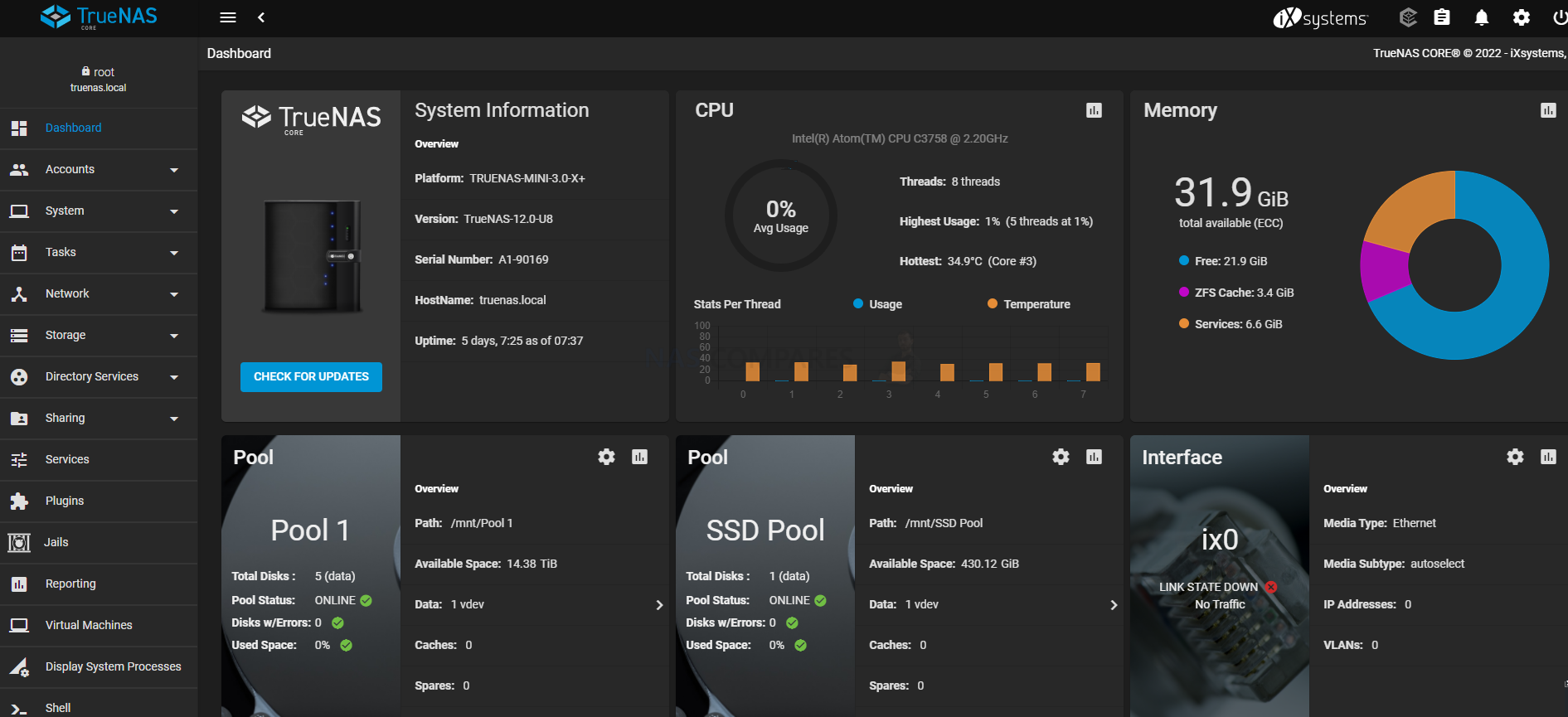
You can find my FULL video and written reviews of TrueNAS Core 12, running on this iXsystems Mini X+ NAS by clicking below. Fair warning, they are really, REALLY long and detailed, so many get a coffee and get comfortable before you head there!
| TrueNAS Core Video Review | TrueNAS Core Written Review |
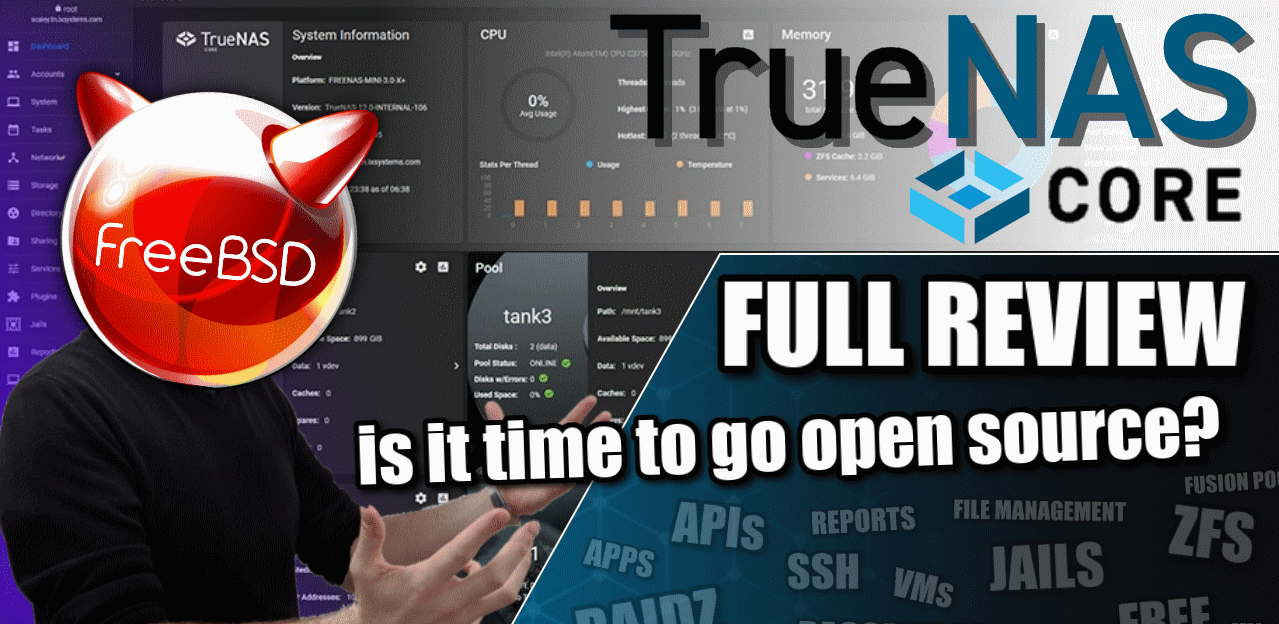 |
TrueNAS Mini X+ iXsystems NAS Review – Conclusion & Verdict

When iXsystems started providing turnkey/off-the-shelf solutions that featured TrueNAS, it was a potentially risky move. TrueNAS has an incredible reputation for being customizable, secure and versatile for storage thanks to it’s FreeBSD building blocks and ZFS structure. But more than anything, TrueNAS allows users to access premium-grade software completely for free. Bundling mostly ‘free’ software into a paid hardware solution is something that means the purchase has a lot more to justify than other solutions. Synology and QNAP have been producing easy to deploy hardware+software solutions for more than a decade now commercially and when buying those, you need to leverage your budget to buy a solution that is a 50/50 or 60/40 split between your money buying the hardware but also paying for the software you are using. So, when reviewing the iXsystems TrueNAS Mini X+, as impressive as TrueNAS is, you need to focus ALOT more on the hardware that you are paying for here as it makes up at least 90% of the purchase. However, I can comfortably say that once you put together the hardware that this system is arriving with (2x 10GbE, 8 core processor, ECC memory, NVMe SSD inside and 7 bays of storage, custom chassis and pre-built), the iXsystems TrueNAS Mini X+ is definitely delivering a lot of bang for your buck! There are a few things I am less keen on, the inclusive warranty seems a little short (it can be extended for a price at checkout) and a few hardware design choices on the chassis baffled me slightly, but if you are drawn to the incredibly flexibility of TrueNAS right now for your home/business storage, but bulk at the idea of going DiY on it, then the iXsystems TrueNAS Mini X+ is a great middle-ground and good value overall. Recommended.
| iXsystems TrueNAS Mini X+ PROS | iXsystems TrueNAS Mini X+ CONS |
|
|
🔒 Join Inner Circle
Get an alert every time something gets added to this specific article!
This description contains links to Amazon. These links will take you to some of the products mentioned in today's content. As an Amazon Associate, I earn from qualifying purchases. Visit the NASCompares Deal Finder to find the best place to buy this device in your region, based on Service, Support and Reputation - Just Search for your NAS Drive in the Box Below
Need Advice on Data Storage from an Expert?
Finally, for free advice about your setup, just leave a message in the comments below here at NASCompares.com and we will get back to you. Need Help?
Where possible (and where appropriate) please provide as much information about your requirements, as then I can arrange the best answer and solution to your needs. Do not worry about your e-mail address being required, it will NOT be used in a mailing list and will NOT be used in any way other than to respond to your enquiry.
Need Help?
Where possible (and where appropriate) please provide as much information about your requirements, as then I can arrange the best answer and solution to your needs. Do not worry about your e-mail address being required, it will NOT be used in a mailing list and will NOT be used in any way other than to respond to your enquiry.

|
 |
Minisforum N5 NAS, 6 Months Later - Better, Worse, the Same?
Beelink ME Pro NAS Revealed
Best SOLID STORAGE NAS of 2025
Should You Worry About the NanoKVM Hidden Microphone?
Best Cheap NAS of 2025
Minisforum MS-02 Ultra - WHO IS THIS FOR??? (The First 48HRs)
Access content via Patreon or KO-FI





Discover more from NAS Compares
Subscribe to get the latest posts sent to your email.


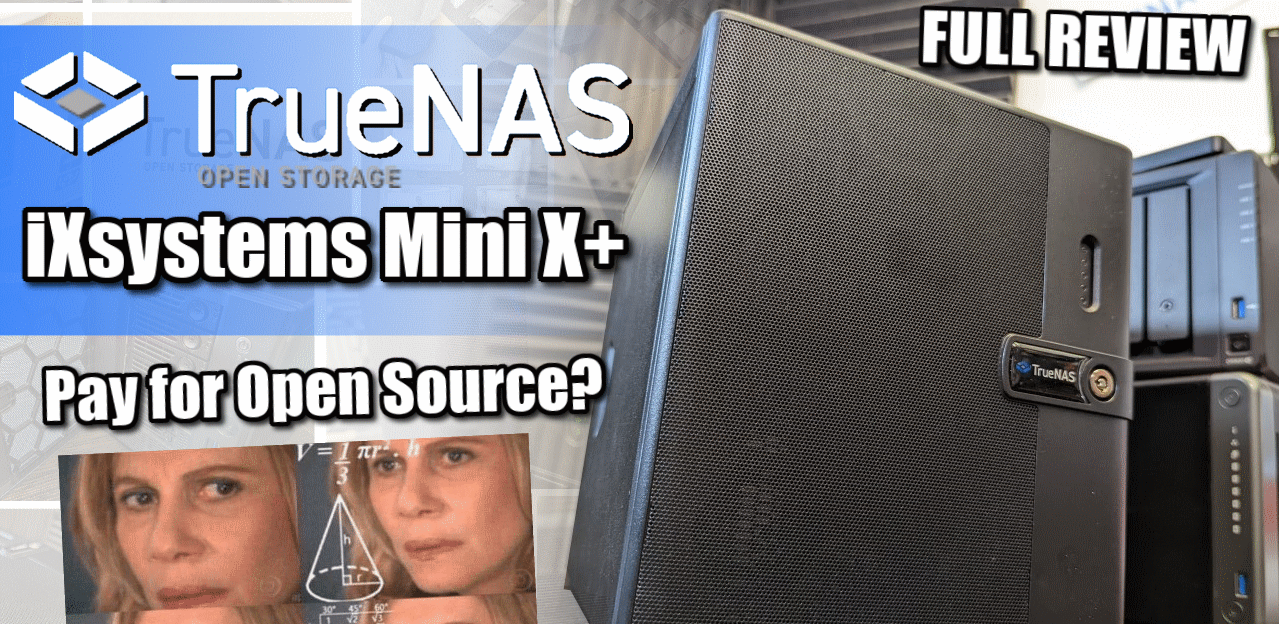



Can we install trienas scale and can natively control leds correctly…
REPLY ON YOUTUBE
Anderson Charles Wilson Charles Moore Steven
REPLY ON YOUTUBE
Have no idea what is going on those permissions.
However.. on my xcp-ng server all i needed to do was to pass through an lsi controller and plug in a disk and by magic it picked it up immediately. Dropped in 5 more driver and a few seconds later i has a zfs pool.. v cool
REPLY ON YOUTUBE
My understanding is “TrueNAS Mini High-Performance 480GB Write Cache SSD (Overprovisioned to 16GB) +$150.00” basically holds the rest of the drive in reserve to replace sectors that fail over the years. Should I populate both 2.5” drives with cache? For the cost of everything an extra $150 is a drop in the bucket
REPLY ON YOUTUBE
there is a reason he doesn’t mention the price
REPLY ON YOUTUBE
I just want to say thank you! I have been watching your videos for a bit now and the passion, and need for the truth with no bull sh#t comes through along with the love of what you do. That’s why I can sit and listen to an hour about True Nas and it is compelling at 58 minutes just as it was at 2 minutes. So again thank you for the incredibly tedious and hard work that you do!
REPLY ON YOUTUBE
Thanks for reviewing this system
REPLY ON YOUTUBE
Thanks!
REPLY ON YOUTUBE
Wait wait, at 21:24 you say it would be foolish to populate with 18TB drives. Why’s that? I’m asking because I have 4×18 in my QNAP and I’ve got two more arriving on Monday.
REPLY ON YOUTUBE
Wait wait, at 21:24 you say it would be foolish to populate with 18TB drives. Why’s that? I’m asking because I have 4×18 in my QNAP and I’ve got two more arriving on Monday.
REPLY ON YOUTUBE
Love your videos! There was a Dora the Explorer moment at 13:19 where I felt compelled to answer… but had no clue what the question was 🙂
REPLY ON YOUTUBE
The VGA port actually makes a good deal of sense, when looking at where you’ll typically find TrueNAS in an enterprise setting. VGA, rather than DVI, DP, or HDMI is pretty much the standard you will find in servers. This helps to cut down on the variance and to standardize on a single type of a connector for KVMs, crash carts, and things along those lines, which you’ll typically find in a datacenter.
REPLY ON YOUTUBE
At this level ideally it needed NVMe onboard so they get the 1100mps speed from the 10Gig ethernet. But at least it has 10gbe so a full 4 or 5 bay raid will get to 1000mps especially with SSDS in raid. Question can we use the Pcie 3×4 slot for a generic pcie to NVMe card ie 2 or 4 slot? If yes i would question why they dont include a $40 PCie card with the device and say it can also have 4 NVMe drives.
REPLY ON YOUTUBE
seagulls, I hope a flock of seagulls! I ran
REPLY ON YOUTUBE
Please I implore you to increase the volume of your videos. I have mild hearing loss, with my headphones maxed out the videos are still quiet.
REPLY ON YOUTUBE
Very interesting review, thank you for doing it. I would have bought one, but I wasn’t keen on it coming from America (despite the packaging!). I guess it may make sense to buy an empty box then buy drives locally. If I had one though, I’d probably end up using the 5x 3.5 bays for a RAIDZ2, then the 2x 2.5 drives for mirrored SSD’s.
I can’t remember if you mentioned this before, but something that’s handy with TrueNAS is that it doesn’t care which SATA port, drives are plugged in to. If you were to remove all drives and throw them in another machine (because of hardware failure, etc.), you just click import and the pool is visible.
The VGA port is a bit odd, but these NAS’s are rarely viewed directly I guess. I did have some funny issues with using DVI, some small monitors just wouldn’t detect – but this can be down to the GPU I used.
SFP+ might have been a nice port to have as well.
Re the Support – that page is identical on Core install, just checked.
Incidentally, I only use TrueNAS due to business use, if I only needed Personal use I would have gone Synology. Business files have actual value, so it’s critical they are are not lost or corrupted.
Very nice though, good to see a this review.
REPLY ON YOUTUBE
Plex,VMs,seed box for unraid. Synology everything else . Do not trust true nas or unraid to be setup remotely and open to the internet. Expandability sucks for zfs
REPLY ON YOUTUBE
i would only use ZFS when they allow you to expand your errays like raid5 lets you…
REPLY ON YOUTUBE
At first a 1-hour video seemed long, but every point mentioned was pertinent. And it’s the weekend anyway, so. 😉
Only addition I would have liked is an overview of network shares management.
And you are spot-on my user usecase/profile: Home techie power user currently using a Synology that likes its simplicity but that still keeps an eye on other totally open source platforms for a bit more control/flexibility (and lot more verbose logs!!). And so I agree with every single of your comments.
Indeed, an “easy” mode in TrueNAS or more wizards across the system would be greatly helpful because I may be tech-savvy at some level, still maybe not quite the TrueNAS level.
So to have something to bridge the gap between current TrueNAS “complexity” and Synology DSM “simplicity” would be perfect.
The other thing that makes me hesitating from leaving Synology ecosystem is the turn-key/hand-holding/well-integrated (DSM/mobile) apps. But even there — and it’s one of the reasons I’m looking elsewhere — is that in the recent years Synology has seemed to neglect all their non-business apps.
REPLY ON YOUTUBE
Compare this to UnRAID also.
REPLY ON YOUTUBE
I would find it very interesting.
If u would test out TrueNAS scale ad the review u have made now about TrueNAS Core.
It’s out of beta and in the release channel.
And it opens up a tons of possibilities as a Linux user, because of docker and k8s.
I really trust and enjoy ur indept reviews.
It would be great to see that for TrueNAS SCALE.
Best regards from me.
REPLY ON YOUTUBE
Adding a comment here to your most recent upload, hoping to get a reply. Watched 100’s of your uploads now. I need a new nas (4-10 bays). My old one died. Won’t be editing on it or doing anything taxing (fancy) with it, so not bothered with nvme caching etc. Just storing/accessing files locally via LAN. Best option? (Ideally with faster than 1.0GBe)
REPLY ON YOUTUBE
I’d be all over TrueNAS (and/or Proxmox), but I have a QNAP TS-453D and for the life of me I cannot boot off the internal drives. No, I am not happy booting off an external USB drive. Do you, or anyone, have any tricks to be able to boot directly off the internal drives on a midrange QNAP device?
REPLY ON YOUTUBE
Please compare to Unraid too. Thanks. ????
REPLY ON YOUTUBE
There is a debian version of truenas called truenas scale
REPLY ON YOUTUBE
Sweet! Great deep dive as always without being intimidating for us newbies rob! – bit the bullet last year on a tvs-h1288x due to your coverage and don’t regret it as it’s been great overall but with all the gross stuff that’s been happening in the qnap camp, definitely considering potentially repurposing it for a truenas. Possible?
REPLY ON YOUTUBE
I’m looking into a NAS system. But I don’t know how much I want to do with it. Right now I only want storage. But I also bought a raspberry pi 4 just for experimenting, and now I have: an add sinkhole, VPN server, Home Assistent, link to smart meter, DDNS server, selfhosted Bitwarden, node red, ZigBee network, and on and on… In just three months. So yea.. it will probably not only be for storage and will take over all tasks from the pi, start media server, couch potato, radarr, lidarr, security cameras with AI face detection, etc. I think I just have to go with TrueNas because eventually I want it all….
REPLY ON YOUTUBE
I was using freenas/truenas before I got a qnap for ease of use. Truenas wipes the floor with qnap, you just need some patience to get your head around the user interface. Please also advise everyone that you can run truenas on an old pc or in a virtual environment to test.
REPLY ON YOUTUBE
Yayyyyy Robbie is back! I bought a qnap based on your review. Your info was great. Its a shame that qnap decided to, there is no delicate way of saying this, shaft thier user base. I really think this is a fantastic idea and would love to see more of your valuable input. Might be time to get the big hammer out and doctor my tvs-1282. Once more it’s good to see you with your enthusiasm for nas. You are back on the watch list. Thank you Robbie.
REPLY ON YOUTUBE
Thanks for this look at TrueNAS. I’m eagerly awaiting your review of that IXsystems box you’ve got there as well as a “Setting Up” video on it. If at all possible it would be nice if you showed a basic, recommended system setup from the point of view of Joe, Jane and Baby Bag-O’Donuts.
REPLY ON YOUTUBE
is there a light mode?
REPLY ON YOUTUBE
I like to see a video how well Plex would work, for transcoding and server multiple users…????
REPLY ON YOUTUBE
Wow, great timing on this review. Been thinking about setting up a freenas box myself.
REPLY ON YOUTUBE
IX-Systems in the UK????
REPLY ON YOUTUBE
Appreciate the DIY coverage!
REPLY ON YOUTUBE
Will you cover TrueNAS Scale??
REPLY ON YOUTUBE
Make a video on how to set up a personal web server, to host a website. If that is possible, using plugins and addons. On TrueNAS Scale.
REPLY ON YOUTUBE